PEOPLE POWER COSY HOMES CLUB
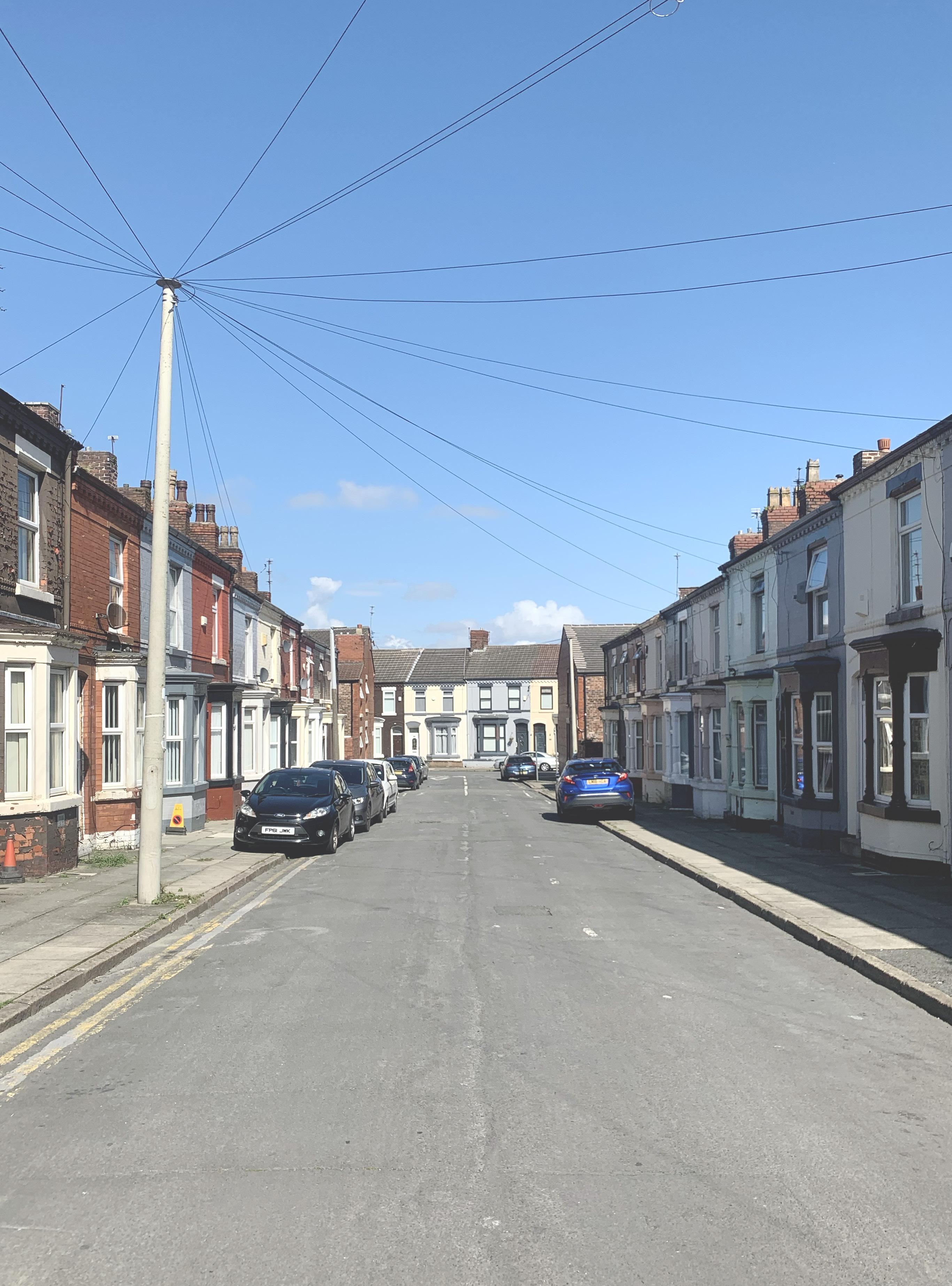




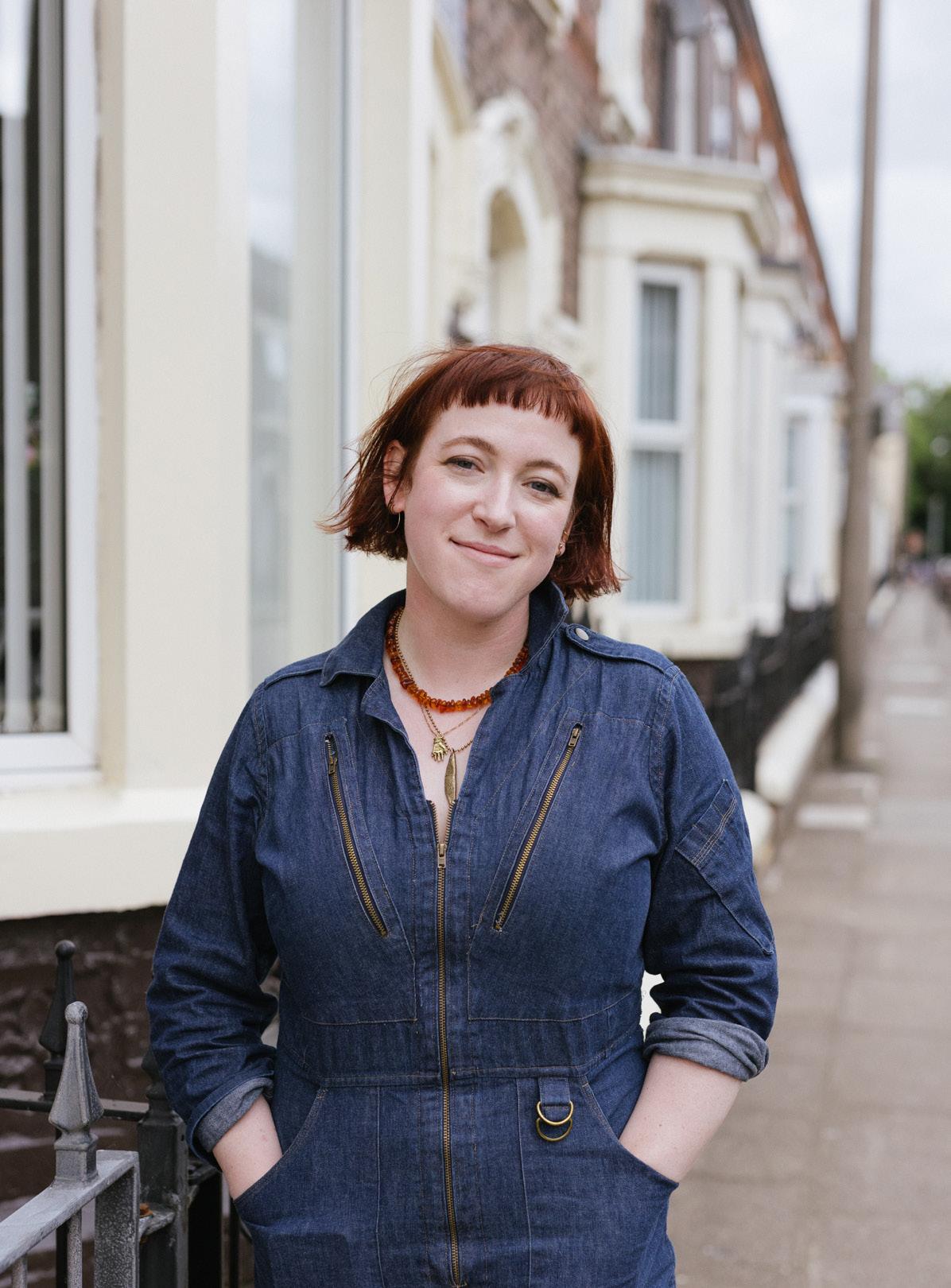
“What does it mean to live well, now and for future generations?
At Homebaked CLT the work we do is guided by asking ourselves “what does it mean to live well, now and for future generations?”. The aim of the Cosy Homes Club is to explore this question in one specific area - by addressing the lack of quality and affordability in housing that we believe everyone deserves. This is a key issue in our community - fuel poverty here is double the national average, and a lot of our homes are in the lowest 20% of domestic energy efficiency. I’m sure you don’t need telling that the recent energy price rises are compounding these issues. During our work over the past year we have heard time and time again, just how urgent this crisis is.
Retrofit is a term that comes up throughout this newspaper - at its core, this just means adding something that wasn’t originally there. When we talk about retrofitting houses, there is a range of things that this could include (see the illustration on pg. 6/7) but in general they’re all aimed at making a house more energy efficient. We know that doing this can help to improve living conditions - a more efficient house uses less energy which means lower fuel bills. It can also mean a healthier environment with less damp and mould, and better air quality. This is all in addition to the wider benefits for addressing climate change and transitioning to Net Zero.
However, current government policy is failing to enable effective widespread domestic retrofit, which is an
issue especially for people who are not able to make these improvements to their homes on their own. So, in the same spirit in which Homebaked CLT initially formed - by local people with a desire to take back control, as a response to the failures of top down regeneration, we, the Cosy Homes Club, are taking matters into our own hands, trying to create the change necessary to improve things for everyone.
In this special edition of People Power, we share what we have been looking at over the past year, hearing from our
team of Citizen Researchers, members of our community, and other experts. If you are interested in anything you read here and want to know more, please do get in touch by emailing me at rachael. branton@homebaked.org. uk. Or visit our website to sign up to our newsletter and keep up to date with all of the Homebaked CLT activities. Together we are stronger, and through this strength we can help each other to grow more resilient, to shape our common future, and to create lasting change!
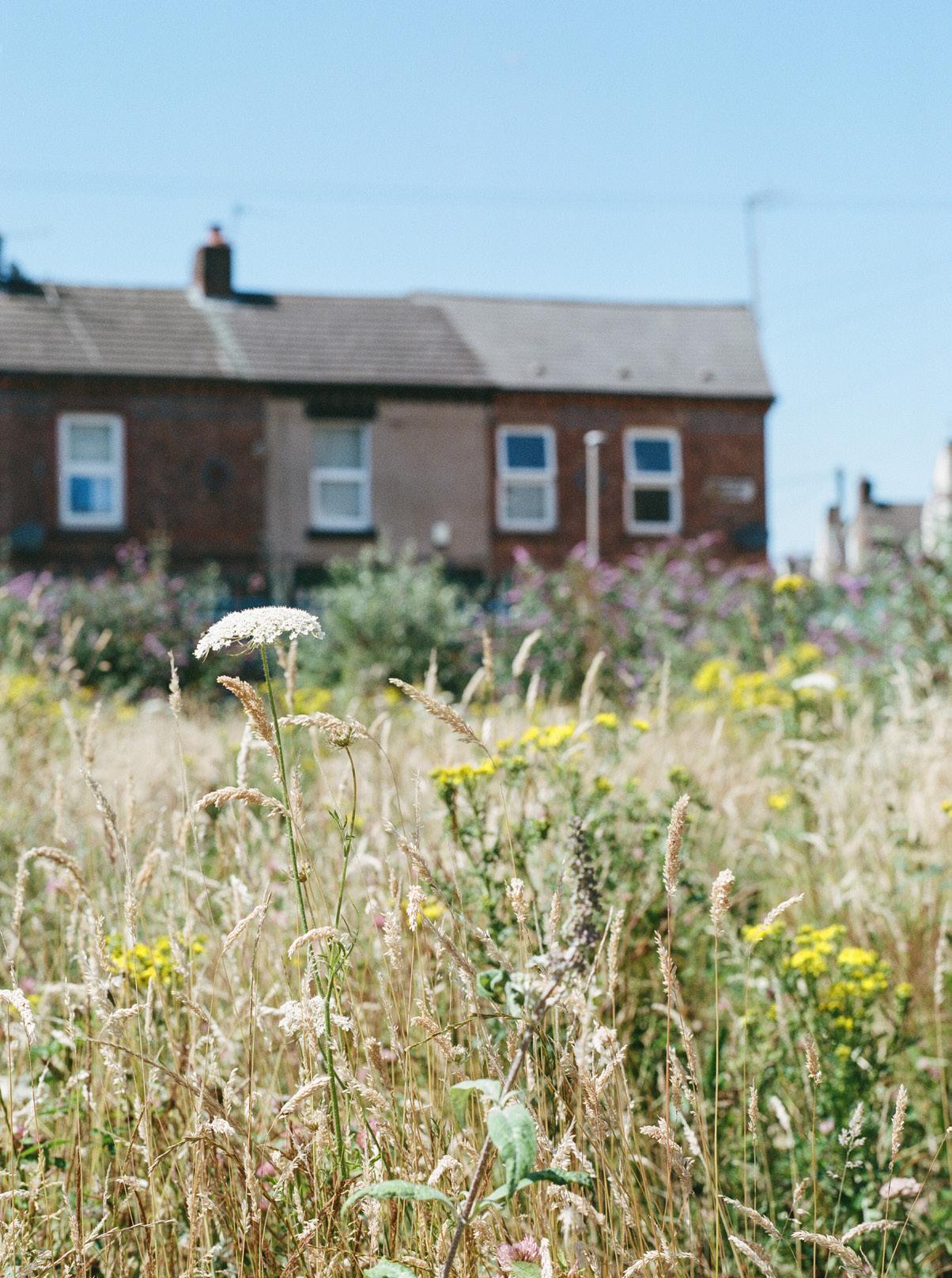
Welome to the Cosy Homes Club
Brick by Brick, Street by Street, Home by Home
Retrofit, Now!
What does it mean to live in a warm and cosy home?
Meet the Research Team
Win-Win: savings for my purse, and the environment...”
Sharing, Learning and Building Solidarity
Dampbusters: Cosy Homes X Mystery Theatre
Home Truths
Citizen researcher Emily Hutchinson and Maria Navarro talk highstreets, housing and community.
Laundry Lessons
Avoiding the damp dilemma with Kitty’s Launderette
Good Food, Our Food
What does good food mean to you? Food stories collected by photographer Emma Case
Slow and Steady
Energy saving meals, that are good for you, and the planet!
Warmer together?
Unesco Who? Scousers are on the job!
An Update on Oakfield Terrace The back page Crossword, Climate Forecast and coupons!
Cosy Homes Club Special Edition
September 2024
Editors: Rachael Branton, Naomi Cull
Original Concept: Britt Jurgensen
Layout & Graphic Design: Rachael Branton
Publisher: Homebaked Community Land Trust
info@homebaked.org.uk
Contributors: Josh Blamire; Rachael Branton; Emma Case, Josh Coates; Naomi Cull; Tom Doubtfire; Helen Grimshaw; Helen Houghton; Emily Hutchinson; Britt Jurgensen; Anthony Scott
© Homebaked Community Land Trust, 2024


When we first started talking about how to keep and renovate our beloved terraces as part of the beginnings of Homebaked CLT in 2010, our architect, Marianne Heaslip from URBED, introduced the idea of a ‘whole house retrofit’. I had to look up the word ‘retrofit’ because it was just not a term casually dropped into the daily conversations, I had been privy to. Much has happened since then. If this subject wasn’t so big and scary, I might dwell for a moment in fascination on the speed with which specific terminology can move from obscurity to everyday vocabulary.
Retrofit: retrospectively fitting energy efficiency measures into already existing homes.
Climate change has become a daily news item. Young people continue to strike from education in frustration with the inertia in the fight against climate change, and local governments across the country and beyond have proclaimed climate emergencies. Those of us who haven’t been impacted directly yet by climate change will most likely know people who have been.
However, I will not write an article detailing the horrors of climate change. Instead,
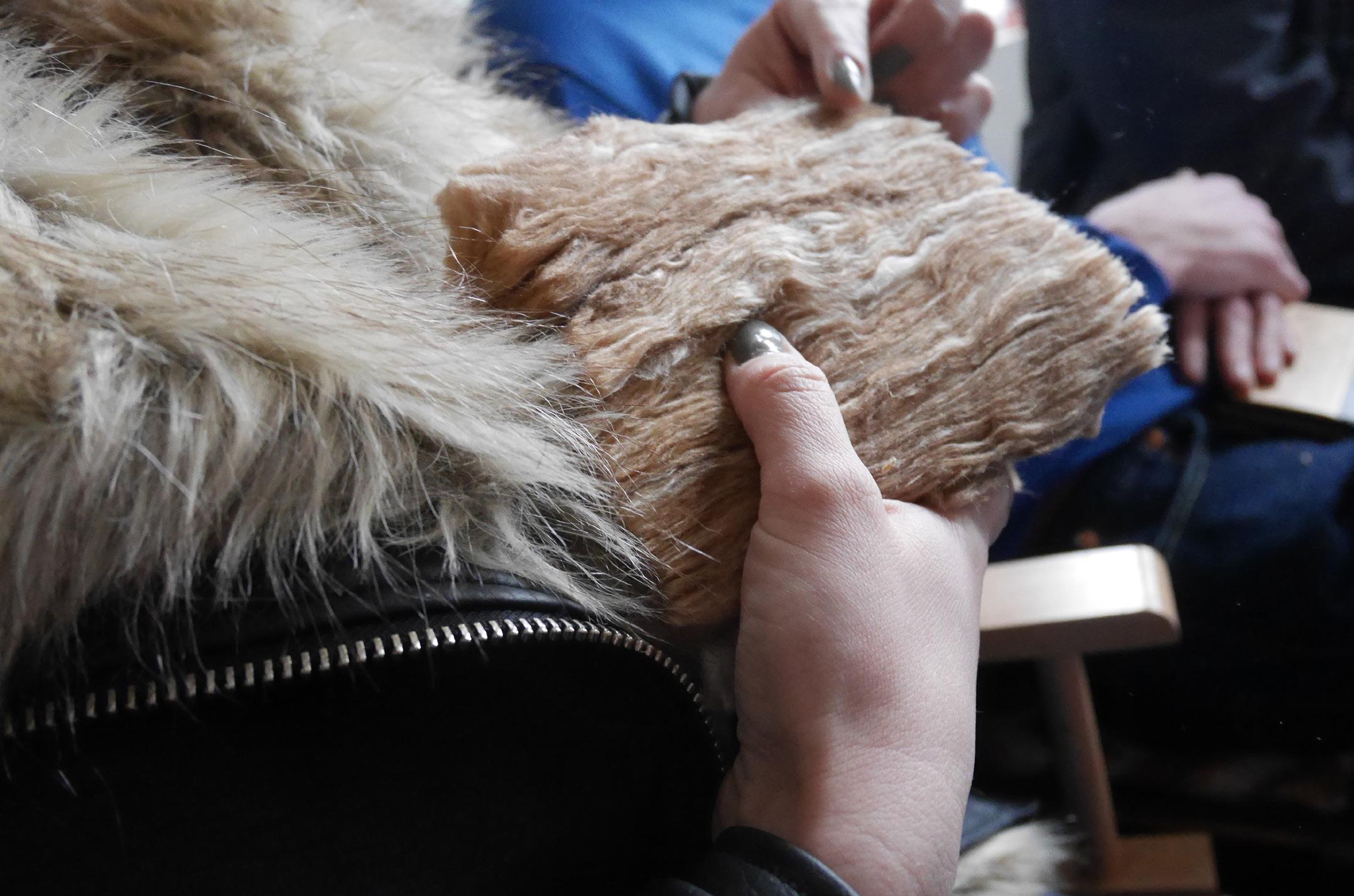
let’s talk about the opportunities that come with trying to do something about it as a community. Or maybe even how we can lower carbon emissions while creating better places to live? I am not kidding! Who knew that subjects such as insulation and heat pumps could create so much buzzing excitement in a room somewhere in, let’s say, Anfield or Everton.
It’s the year 2018. Twenty local people sit around a table in the back room of Homebaked bakery, planning how
they want to transform the derelict and beloved neighbouring terrace. Marianne says jokingly, “Thanks for giving up your Saturday morning to look at dilapidated houses!” Today, we discuss energy efficiency and low carbon housing. Part-way through the conversation, somebody says, “wait a second, I want my home to be like thatwarm and comfy, no mould, lower energy bills, cleaner air and a cleaner conscience. Isn’t that a no-brainer?’ Let’s start at the beginning, though. Maybe you don’t
“Wait a second, I want my home to be like that - warm and comfy, no mould,
lower energy bills, cleaner air and a cleaner conscience. Isn’t that a no-brainer?
Marianne’s aunt’s home in Cumbria has been flooded several times. You can see the latest flood level here on their family heirloom. Image credit Marianne Heaslip.
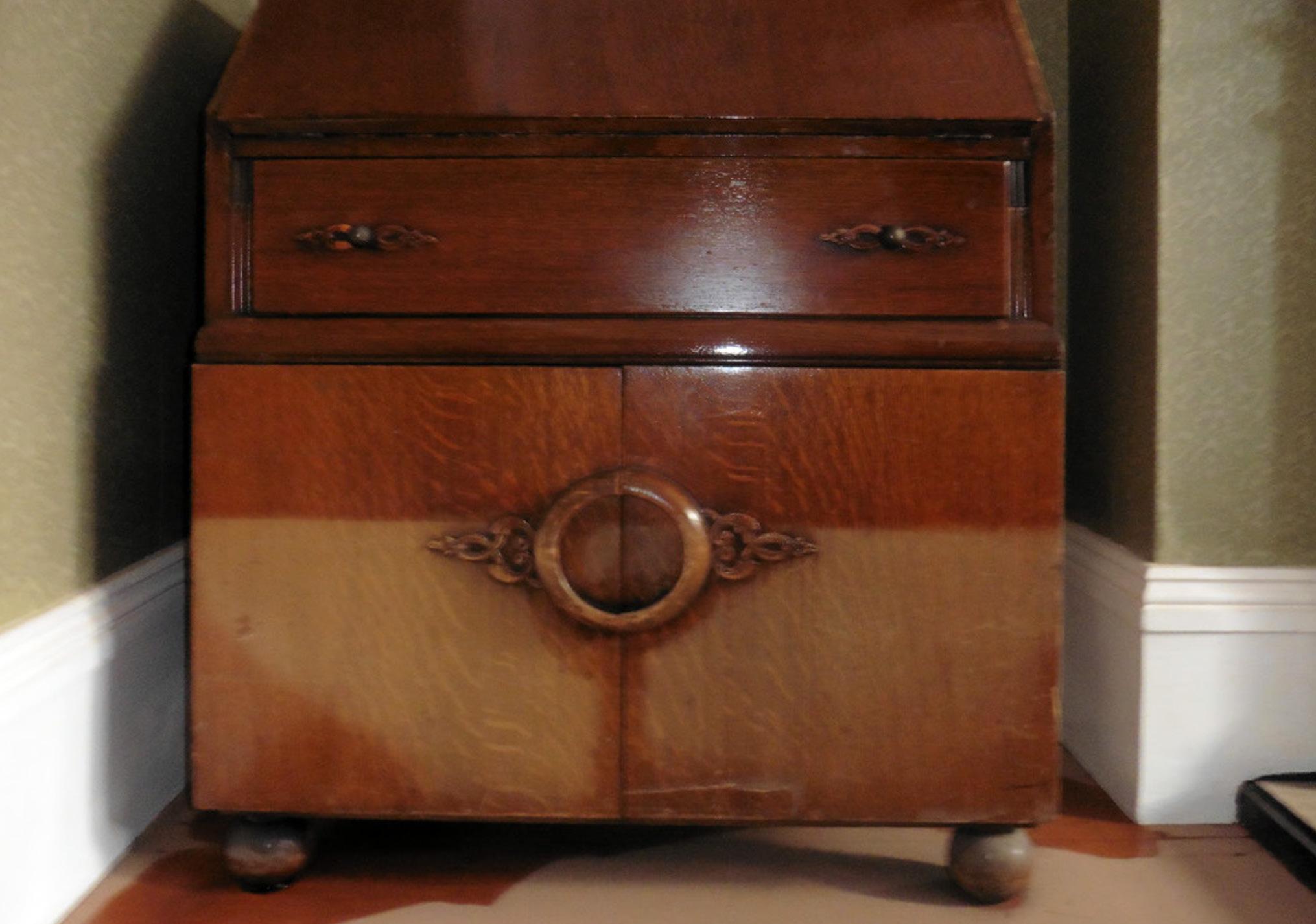
know what ‘decarbonising the energy system’ means or why making existing homes more energy-efficient is such an important step towards mitigating climate change. I certainly didn’t! So here is my pop knowledge summary for you to enjoy!

heat our homes, in industries and for transport.
1. Zero Carbon Britain report by Centre for Alternative Technology (https://cat.org. uk/info-resources/zero-carbon-britain/research-reports/ zero-carbon-britain-rising-tothe-climate-emergency/)
2. Committee on Climate Change (2019) UK housing: Fit for the future? (https:// www.theccc.org.uk/publication/uk-housing-fit-for-thefuture/)
Human beings have been burning stuff to keep warm, create light, and be fed for millions of years. First, we used wood, and much later also coal, gas and oil. The latter are fossil fuels, i.e., fossilised plant matter pressed down or trapped in liquid or gas that form in the earth. It was from the industrial revolution onwards that we, in the global North, went completely overboard with extracting those fossil fuels and burning them. First to fire our mills, and soon for pretty much everything, from blow-drying hair to powering trains. Quite early on, we learned that, in the form of electricity, energy can travel with little loss from a generating plant into factories, businesses, and homes and be easily transformed into motion, light, and heat. And even though we had figured out already then how to convert wind, water, and energy from the core of the earth (geothermal) into electricity, burning fossil fuels was more convenient and, most importantly, profitable - at least for some. Since we started using electricity in the 1890s, and until recently, a major part of it has been generated by burning fossil fuels. In addition, we use gas and petrol to
Burning fossil fuels releases carbon stored in fossilised plant matter into the atmosphere in the form of a gas (carbon dioxide or CO2). This is more CO2 than plants and oceans can absorb in their natural cycles and creates ‘the greenhouse effect’: trapping the sun’s heat, warming up the earth’s surface and changing our climate. The follow-on effects are very hard to predict in detail but, if not mitigated, will make our planet uninhabitable for most species
‘Decarbonising the energy system’ means to stop burning fossil fuels and to convert the electricity we need from renewable energy sources like wind, water and the sun instead. In other words, to prevent the worst climatechange predictions, we need to ‘power up’ renewable energy. However, projections show that if we continue to use energy at the current rate, we will not be able to meet our growing energy demands with renewables. So, we must also ‘power down’ our energy use 1.
This is where we land back in that little room in the back of Homebaked bakery on a Saturday morning. We are talking about an approach that Marianne calls ‘fabric first’. 20% of the energy consumption in the UK happens in people’s homes, and by far the most significant part of that energy is needed for heating (and
increasingly cooling). In the UK that heat comes mainly from burning gas 2. And a large amount of it, especially in older buildings, leaks back out through surfaces, gaps, and cracks – literally heating the outside. Leaky homes are not just bad for the environment, but also for our wallets and - when we turn down the heating, because we just can’t afford it anymore - for our health, both physical and mental. Especially in neighbourhoods like ours where nearly a quarter of our community live in fuel poverty (i.e. they can’t afford to heat their homes adequately), improving the energy performance of a home can be a lifesaver in the true sense of the word. The best way to power down energy use in a building is by insulating it really well and sealing all the gaps and
The best way to power down energy use in a building is by insulating it really well and sealing all the gaps and cracks where heat could escape.
cracks where heat could escape. We need to take care of the fabric of our home first – it’s walls, ceilings and floors. “It’s like putting a blanket on your home”, says Marianne.
It is no surprise really, that our core design team of local representatives prioritised ‘whole house’ retrofit for the Oakfield Road scheme. We will be able to reduce the energy need for heating substantially when compared with other similar properties in the surrounding area. We also propose heat pumps, using electric heating technology to replace gas. Heat pumps are very efficient, but only in a well-insulated home. Oh, and then we add solar to be our own little power station that can create clean energy and make us less dependent on the very volatile market! These measures mean that our tenants will be warmer and healthier, reduce their bills by half and their carbon emissions by 75%.
“The really boring thing about all this is that it’s basically common sense and attention to detail”, explains Marianne. “Use good, solid materials and avoid showy ‘eco-bling’”.
Heat behaves like water. If you have ever tried to keep water in a bucket with even the tiniest hole, you can imagine how important attention to detail, and quality is in this line of work. The best design or materials are worth little if the builders cut corners or don’t have the necessary skills. Equally, of course, if we were to roll out retrofit
in the whole of Everton and Anfield and train local people accordingly, we could create many new local jobs and strengthen our local economy 3 It’s a win-win, really; however you look at it.
It’s a win-win, really; however
look at it.
So, if retrofit is such a nobrainer, then why exactly is the UK lagging so far behind national targets of creating warm, healthy homes with affordable bills across all our neighbourhoods? It’s not that public bodies are not aware that domestic energy efficiency is both a big issue and a great opportunity. In their report ‘Housing fit for the Future’, the UK Committee for Climate Change calls for retrofit to be considered a “national infrastructure priority” and calls for immediate action by national and devolved governments. There have been countless programs and policies over the years. Some of these have failed spectacularly, some do okay, some seem to just have fizzled out, but overall, the uptake is often not as good as expected. So why is that?
Whilst retrofit sounds like a straightforward solution: ‘Just pop in some insulation’, the reality of a national retrofit roll-out is more complex than one might think. We are talking approximately 25 million households spread across the UK. A fifth of those live in private rented accommodation and have very little power over home improvement to begin with. Unlike in Oakfield Terrace, most of those 25 million homes are lived in and retrofit becomes a continuous process, negotiated in relation to people’s every day, our way of life, our economic conditions, how we consume energy, our tastes and the social norms in our communities. Every reality of living in a home is different. Every neighbourhood, every street and every home are
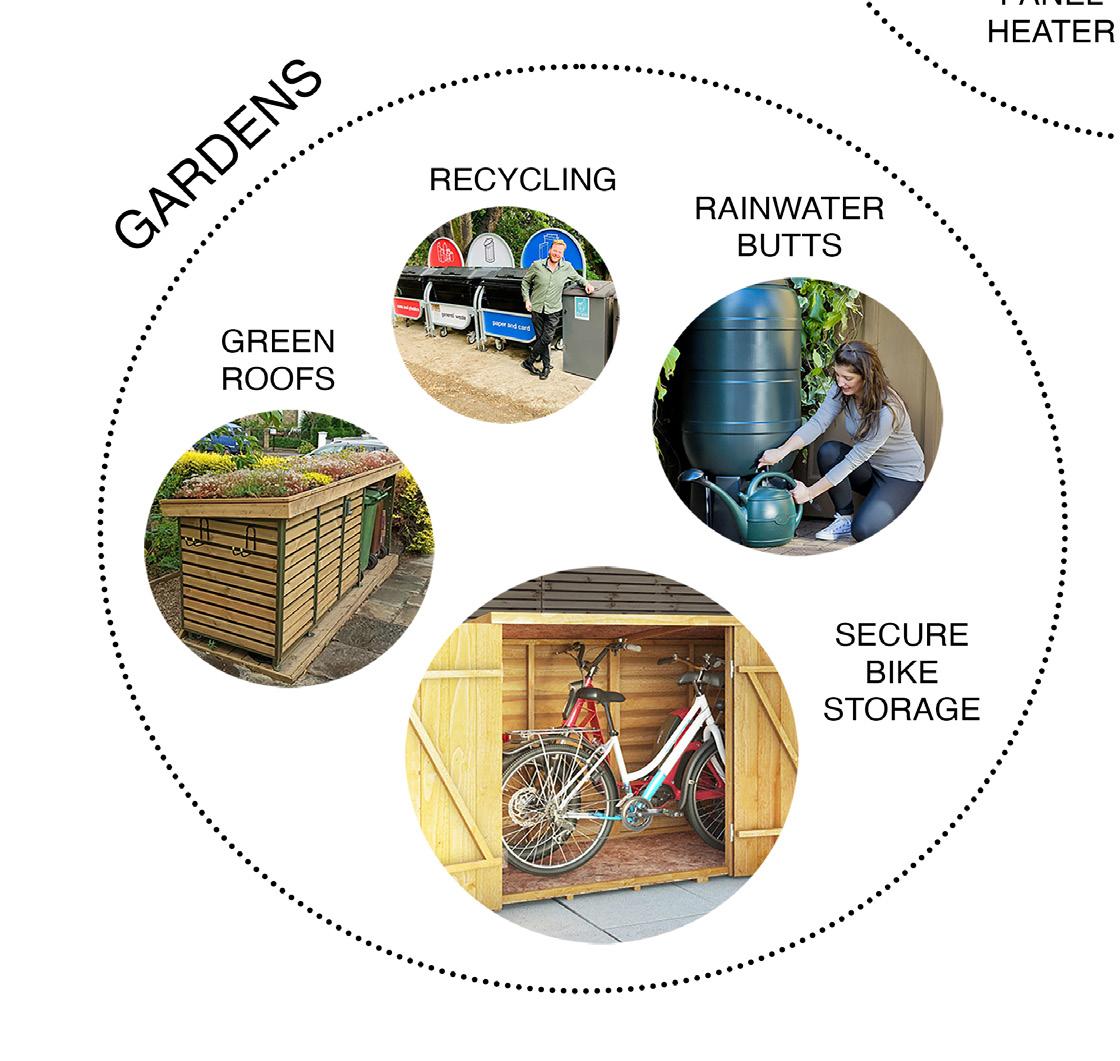

3. New Economics Foundation research has found that a national house retrofit programme could create 500,000 jobs.
(Building a green stimulus for COVID-19, a recovery plan for a greener, fairer future, NEF, 2020)
different. No one size solution will fit all.
And as the homeowner, we are not the only actor in that system by any means. There is the question of fit for purpose finance, the construction company and their capacities and quality of care, and the mediators that help us to plan and project manage, to benchmark quality and learn to use our new old home.
And all the above is assuming that I, as the householder am even aware of the change that I can make to my life, my community and the planet by doing an energy efficiency renovation of my home.

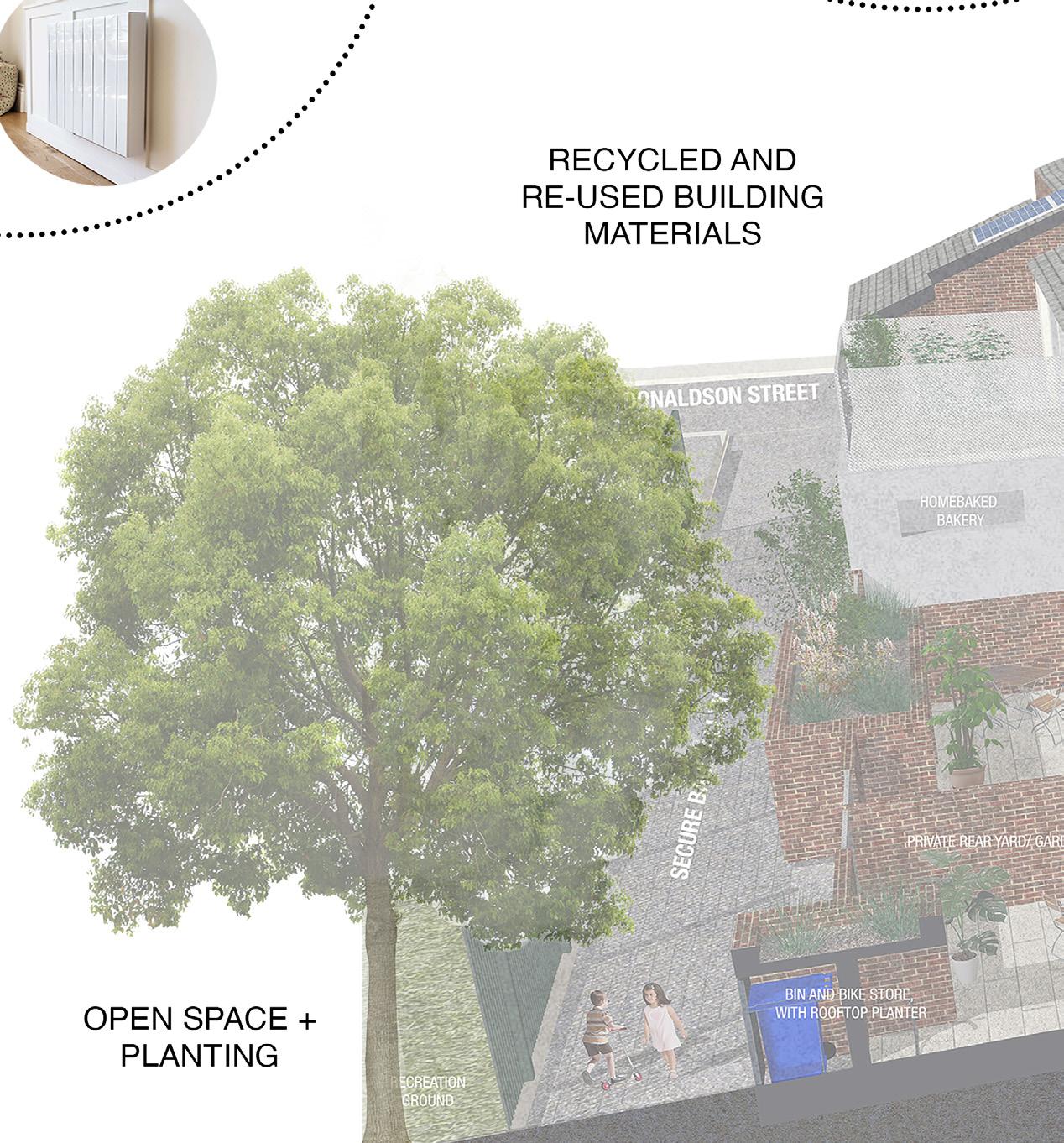

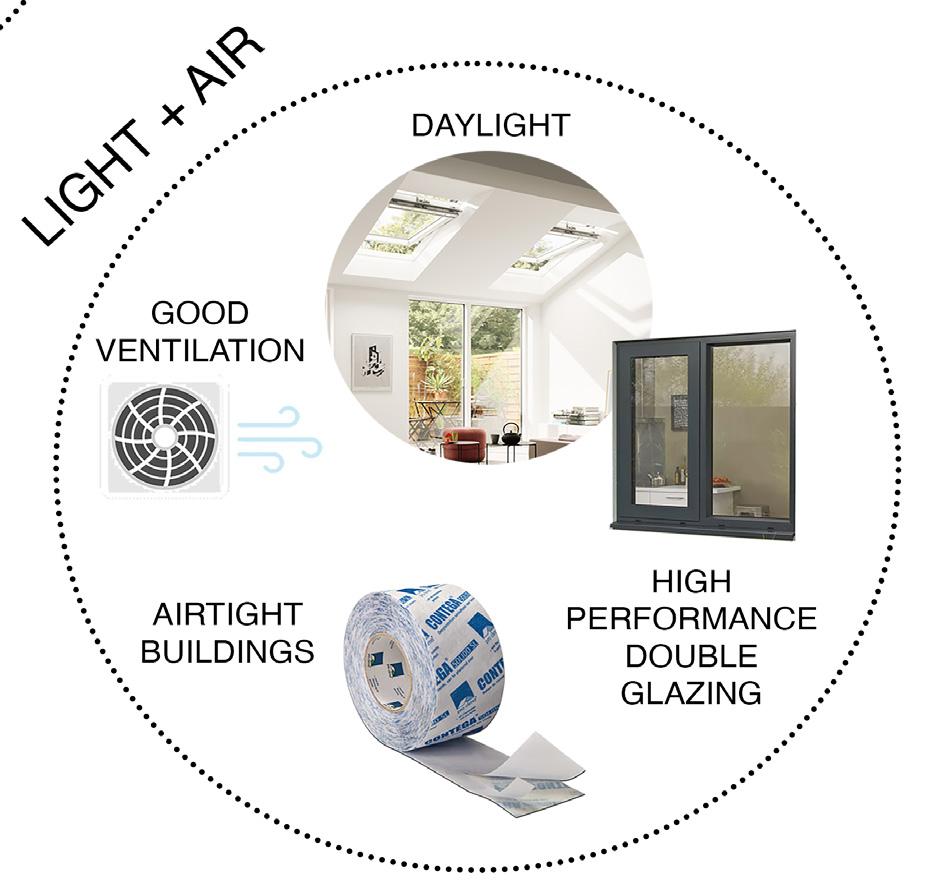


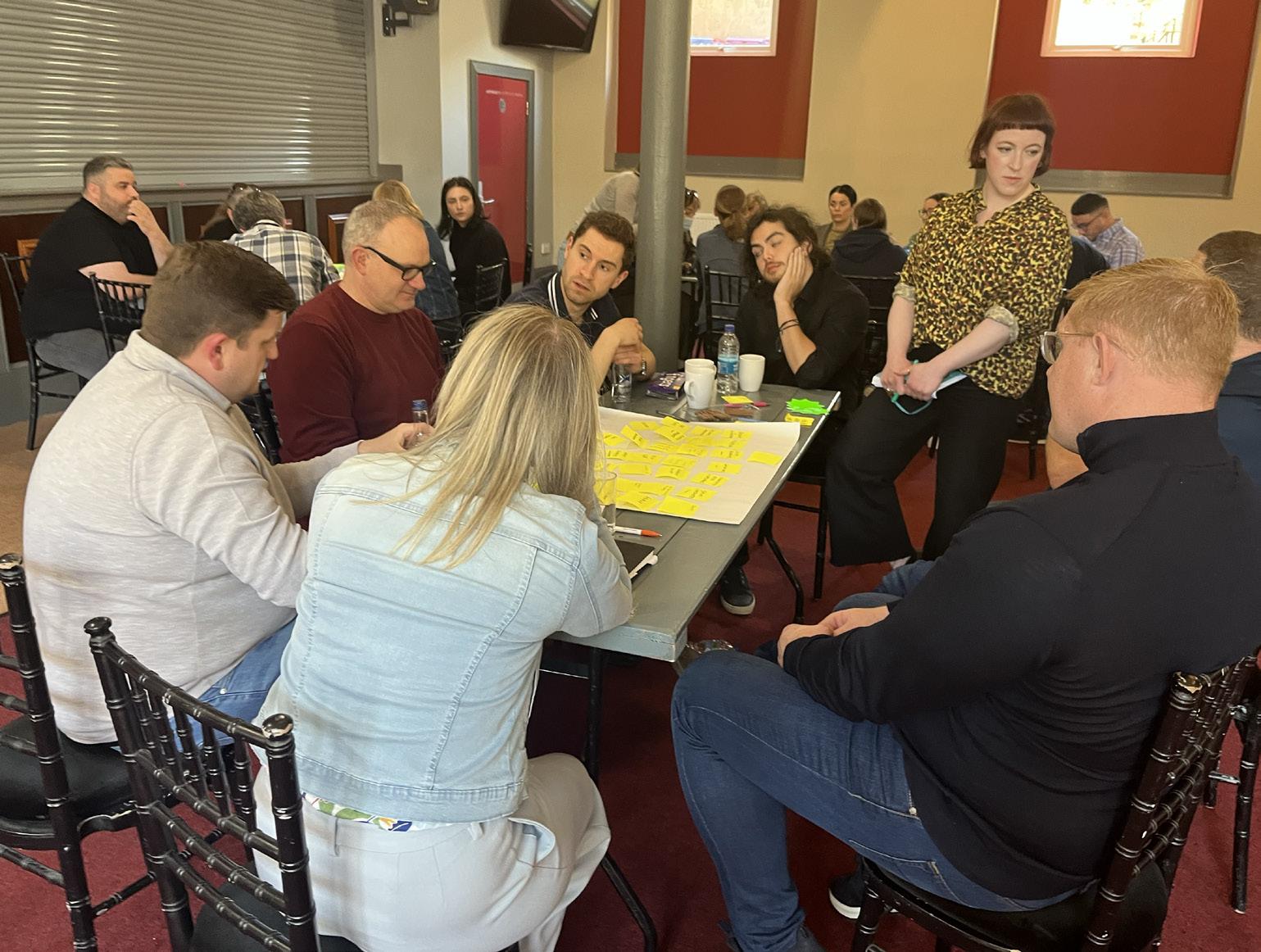
It’s 2024 - We are sitting in Kitty’s Launderette between clean and not-yet clean laundry. There are local homeowners and people living in private and social rented accommodation, community-leaders and energy experts in the room. We are talking draughts and how to stop them. The room is buzzing with conversation and excitement, everybody seems to feel empowered and confident to contribute from their experience. “Start a revolution, invite your neighbour.” (Slogan adapted from our friends at Mikropol, Hamburg) 4.
After our initial retrofit learning journey with Oakfield Terrace and when our communities were hit hard with the cost-of-living crisis, we decided to see what it might
take to spread that blanket across our neighbourhood and help build a not-toodistant future where everyone lives in a cosy home with affordable bills. We think that with a multi-actor and complex problem like this, it helps to add people and place to policy and create a living example of community-led and collective retrofit – we want to say, ‘across an entire neighbourhood’, but maybe let’s start with a couple of streets, hey? And like with everything we do, we started by asking our members and neighbours ‘What do you need to live well? What would you need to be able to retrofit your home?’ And maybe most importantly: ‘How can we work on this together? What if we pooled our resources?’
4. Slogan adapted from our friends at Mikropol, Hamburg. Mikropol is a self-organised community centre in a former public toilet house in Hamburg with the Motto ‘Start a revolution – get to know your neighbour’ (https://mikropol.de/de)
We started the Cosy Homes Club as a way to listen, learn and build the relations, capacities, engagement and mutual support that we need locally to make this happen. We bring everyone together who has a stake in the matter (local builders, homeowners, landlords, tenants, people from the council, advisors, local community organisations and schools) and have started to map out what a ‘that size fits us’ solution could look like. We train local citizen researchers to analyse barriers and opportunities specific to our locality and communities. We create fun and safe spaces to learn together and share advice. We invite our neighbours to our homes to experience and talk retrofit. And we hop on a bus together to visit other neighbourhoods and learn from them.
We haven’t got all the answers yet.
But we are on the way.
Our movement is growing.
Join the Club.
What does it mean to live in a warm and cosy home?
Over the past months we’ve been exploring this with our local community in Anfield and Everton. We’ve been having conversations with people in their homes, in food banks and pantries, at the church, the launderette, in cafés and pubs, and other community spaces. We’ve held pop-up stalls, workshops, and a film screening to ‘spark’ discussions about housing and energy with the diverse people living in our neighbourhoods. We’ve also explored this question with local business owners, landlords, builders and contractors, and community activists.
This is what we found.
Fuel poverty in Anfield and Everton is double the national average, and many people are struggling to pay their bills given soaring energy prices and a cost-of-living crisis. During our research, people spoke to us about
the negative impacts this was having on their mental health and wellbeing. Maria, 62, who has lived in Anfield most of her life, first in the older terraced housing that was demolished before recently moving to a nearby
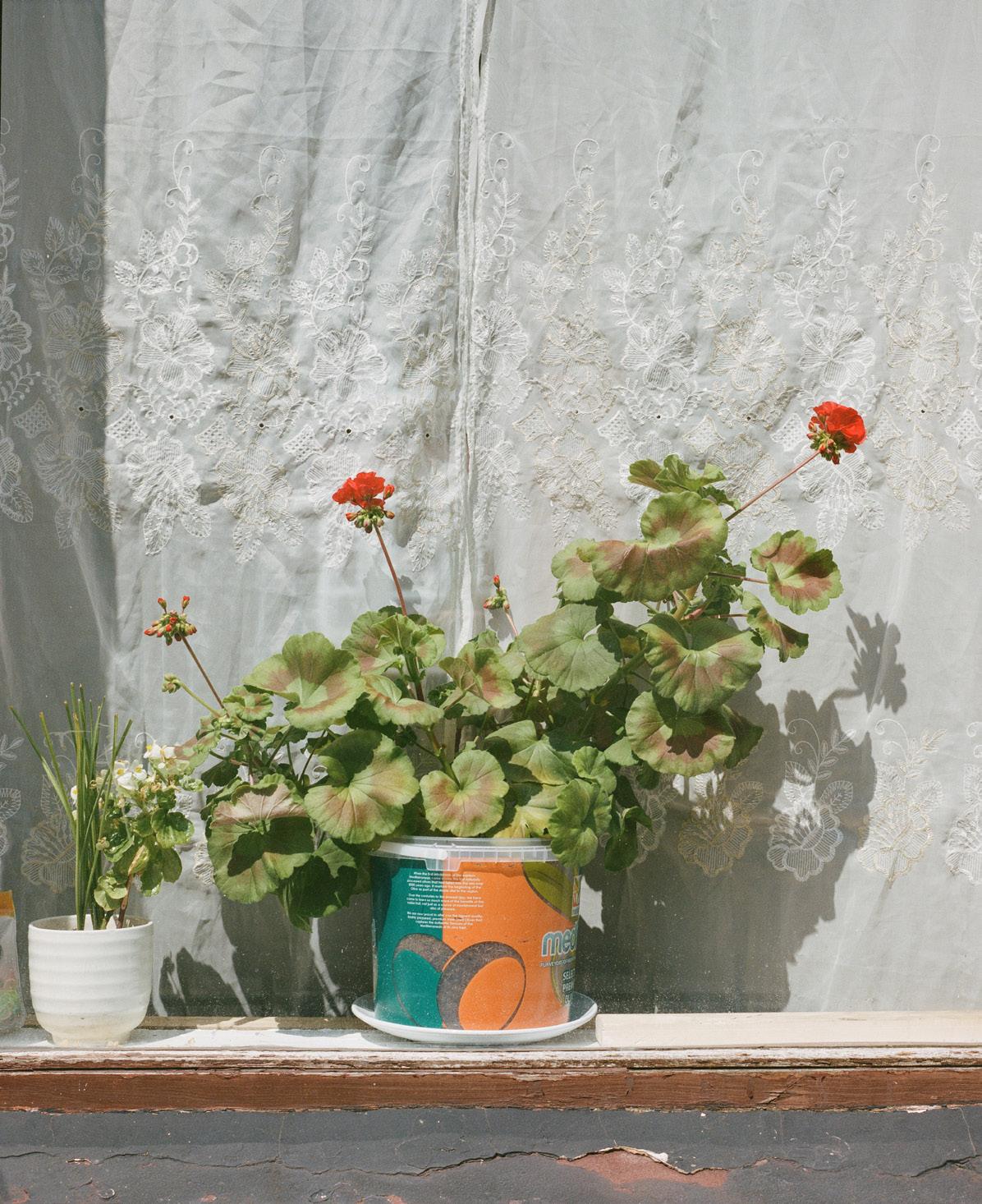
new build, told us “they [the energy companies] threaten me every so many months […] I can literally feel the blood draining from me because I’m like: how am I going to pay this?!”.
Katie is in her late 20s and recently moved to a property in Kensington having privately rented a house in Everton for seven years that did not have central heating. She reflects that “I thought I was a bit sad, but I was just fucking cold”. Expensive energy bills combined with rising rents and mortgages and a lack of secure, well-paid work have put real strain on an area that people noted has long struggled to keep up with the cost-of-living.
Hear more from Maria in ‘Home Truths’ on pg. 14
This is an emergency laid bare by the measures that some people are needing to take to save money, such as only heating one room, reducing the number of showers they take, and not washing clothes as often. Doris, a woman in her 70s, who owns her home in Anfield, told us how, since
the death of her husband, she had been living in the kitchen, relying on heat from the cooker. Some residents are falling into debt and, while others report feeling ‘lucky’ that they can afford to pay their bills, and empathise with those that cannot, the costof-living crisis may still be hitting them in other ways.
“I thought I was a bit sad, but I was just fucking cold.
With many homes in the area first built in the 1880s, our older housing stock is in a poor condition and our homes leak heat. Lots of people reported the build-up of damp, condensation and mould in their homes, while older houses are particularly susceptible to draughts, leaks, and have features such as high ceilings which make them difficult to heat (bearing in mind they were initially designed to be heated by coal, which was plentiful at the time). Rev Mikey Ferguson visits many members of the community at their home through his work with St Pe-
ter’s Church, Everton. He sees lots of people who are struggling with cold homes. “The front doors let out so much heat [they] might as well be open”, he remarks. Alice, who
is in her mid-40s, moved to Liverpool from France some twenty years ago. Below she describes her experience of private renting in an HMO (or house of multiple occupation:
“So I had this big old room with massive ceilings, no insulation whatsoever, no double glazing. The window was broken. I was so cold. There was no central heating. I had to use those electric heaters that were using a lot of energy and the meter was a prepaid meter but not even with a card or fob, I’d have to put in pound coins […] The bathroom and kitchen were on the other side of the landing, going to wash was just a nightmare. I wasn’t washing every day. My mental health was at rock bottom, you know, it was horrendous.”
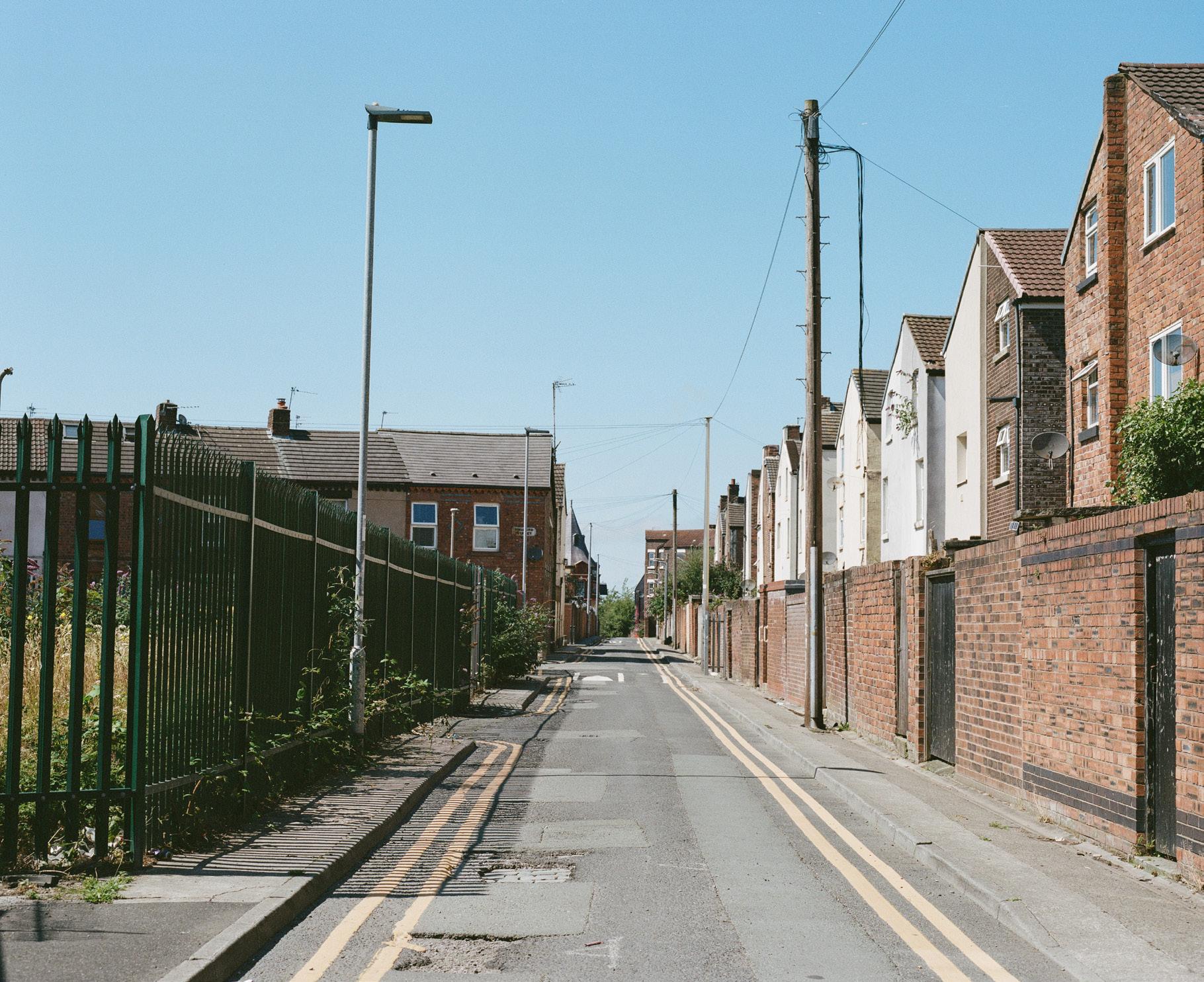
So, much of our housing stock is in desperate need of upgrade, be it replacing old windows and doors or underperforming heating systems. Residents also noted the poor state of our wider built environment, such as uneven and unsafe roads, lack of parking, and the build-up of rubbish in entries that attracts vermin, while we have witnessed several buildings collapse over the past few years.
This is coupled with a broader crisis in housing related to a lack of affordability, overcrowding in some homes while other houses remain empty long-term, and years of stunted local regeneration politics. And, although the area has recently seen the development of many new build homes, the local people and housing activists that we spoke to tended to agree that these houses are not being built to a sufficient standard to help cut bills and ensure that residents stay warm (and consequently will likely need upgrading in the future). There was also
If you’re struggling with the cost of washing clothes, or with damp from drying them indoors, Kitty’s Launderette may be able to helpread ‘Laundry Lessons’ on pg.17
a feeling that some private landlords – several of whom live afar – are not properly invested in the area and do not take good care of their tenants and their properties (although other landlords were seen to be more socially responsible). For instance, one tenant who has lived in both social and private-rented housing in the area said that some private landlords and letting agencies are not being held accountable for problems and repairs: “when you do make a complaint it’s almost like [they are] looking down on you and saying: ‘who are you to complain, just be thankful you have a roof over your head!’”.
At Homebaked CLT, we seek to ensure that homes are high-quality and affordable to local people, and that we live in an environment that provides good jobs, green space, and proper opportunities for our communities to thrive. So, how do we get there?
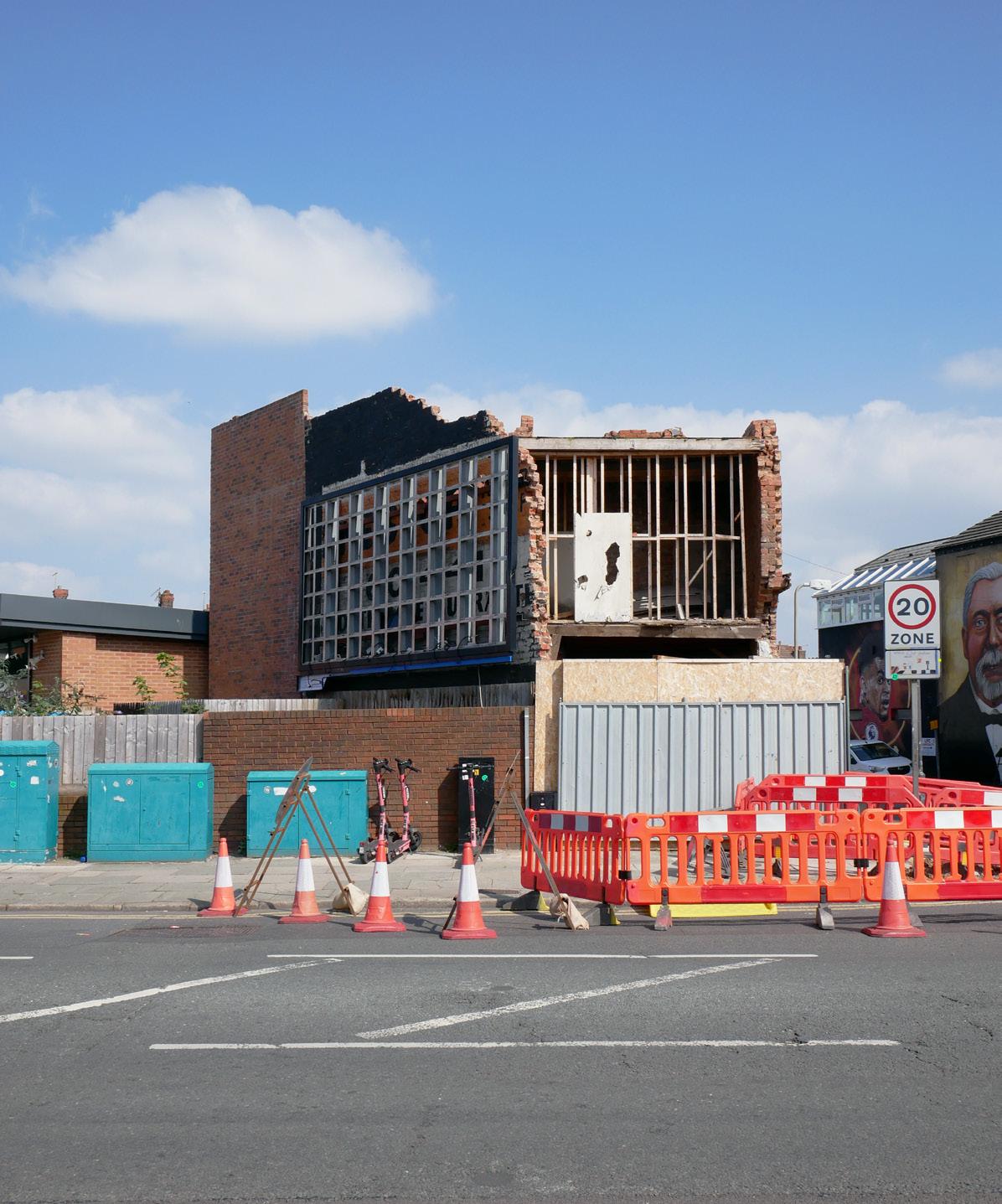
‘Retrofit’ is the technical term for making upgrades to your home to increase energy efficiency and to help create warm homes and cut the cost of bills. While many residents are taking steps to keep themselves warm – such as wearing extra layers in the house – we can apply similar measures to our homes. This could be DIY-style draughtproofing or simply switching to more energy efficient lightbulbs, but could also include work carried out by building professionals such as installing loft, wall, or underfloor insulation, solar panels, and heat pumps. We learned that a few individuals and families in Anfield and Everton have already begun to ‘retrofit’ their homes and as a result are seeing cost savings. But for many in the community it’s not that easy.
The work needed is often too costly and not everyone qualifies for grant funding. There is also a lack of local trusted traders, and people fear that building work will be disruptive and invasive, or may damage the character of their older homes. And, while housing associations across the city are beginning retrofit work on their properties, homeowners and private tenants we spoke to wondered
how they might access support for making adaptations. The answer, we think, lies in developing a community-led area-based retrofit scheme that involves scaling-up this work at first a street and then a neighbourhood level, leaving no one and no home behind.
Anfield and Everton suffer challenges including high levels of poverty worsened by austerity, and poor health, while our neighbourhoods are undergoing rapid change that is associated with the growth in temporary accommodation in the area and the recent arrival of a more transient population that is younger and more culturally and ethnically diverse (which too brings positive opportunities). Many of our conversations showed that the housing demolitions of the previous decades have instilled a
sense of grief and loss that has taken time to overcome, and long-term frustrations with attempts at regeneration have led to a sense of lack of ownership and control of the area. Yet, those who live and work here spoke of close bonds with their neighbours, a strong sense of local community, and of
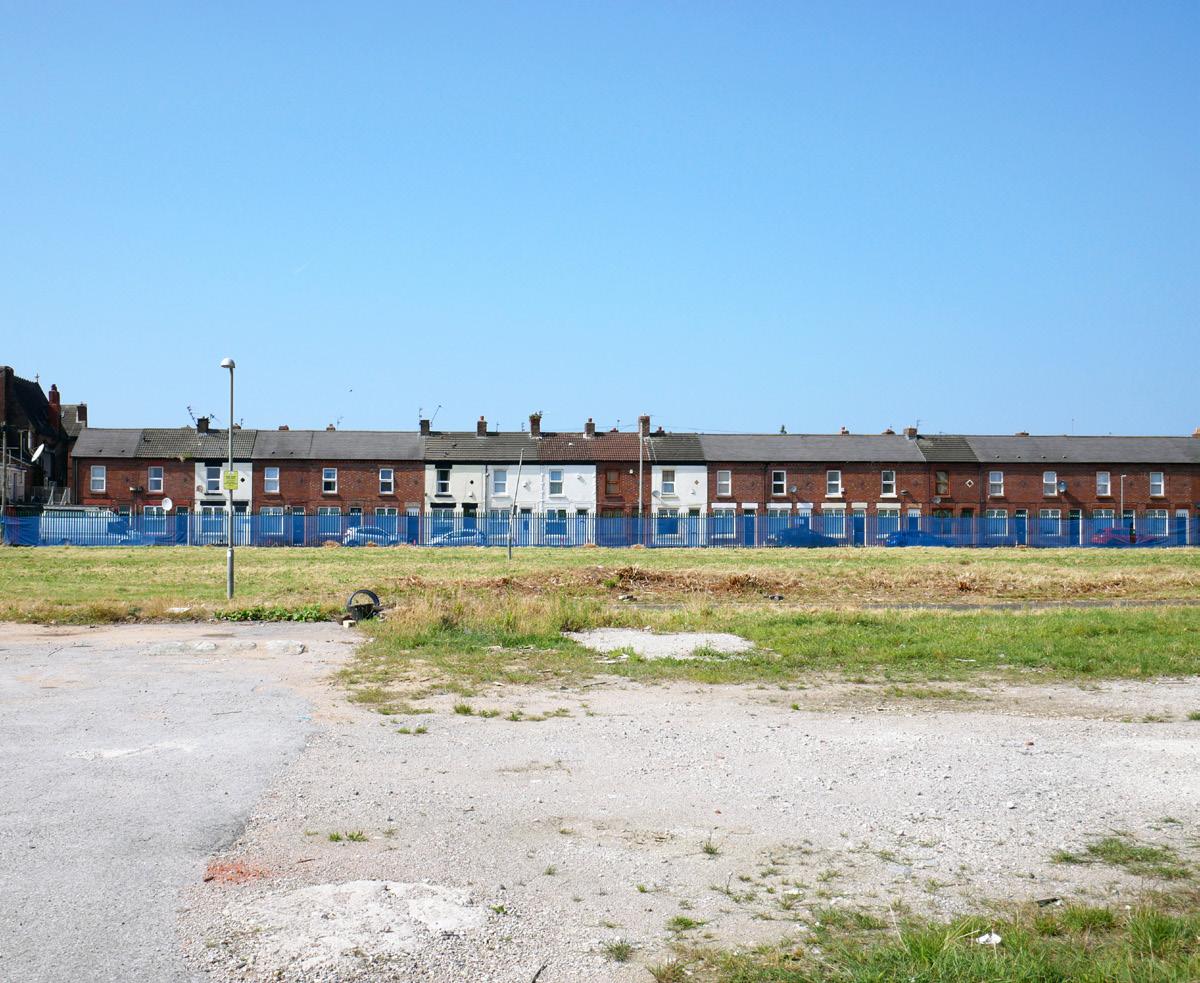
its many valuable assets (such as social enterprises, social spaces, charities and faith organisations). This demonstrates the potential for building a neighbourhood
retrofit scheme that is led by the community and enables us to move forward together – long-term residents, new arrivals, and visitors alike –with hope for the future.
“Everton has never struggled with spirit, it’s a very unique place. There are some great communities in this area, we all look out for each other.
Janet, mid-60, long-term resident living in social housing
Want to know more?
If you are interested in learning more about the research, or hearing about our next steps, get in touch with Rachael Branton (rachael.branton@ homebaked.org. uk) or Josh Blamire (j.blamire@wlv.ac.uk).
Aside from warmer homes and cheaper energy bills, what else can community-led retrofit do for us? For one, reducing or even removing entirely our reliance on fossil fuels for heating will provide a big solution to the climate crisis. The ongoing war in Ukraine has also emphasised the need to establish energy security within the UK. Speaking with people in Anfield and Everton, there was strong enthusiasm about the prospect to create high-quality jobs
and training for local people within the retrofit industry, building community wealth and enabling the area to thrive once again. As local community activist Sam noted: “what people need is jobs that they feel proud of […] and I think [housing retrofit] should be a beacon for across the city”. On an individual home level, upgrading housing infrastructure can lead to improvements in physical and mental health and
wellbeing, a greater sense of security in one’s home, and even potential increases in house values, a win-win for all (see the article on pg. 12 by local resident and community researcher Helen Houghton for more on this!). Yet, despite growing appetite within our communities to take back control, direction and leadership from central government has been lacking, hence the urgent need to start this work from below!
We believe that fuel poverty and poor housing conditions are systemic problems, and that as the most affected communities, we should be at the centre of shaping the interventions needed.
This is why, at the very start of this project we put out a call out for local residents who were interested in using their local knowledge and experience to shape the research process and make sure that it truly represented our area!
Here, the team each explain a little bit about themselves and their motivations for getting involved with the Cosy Homes Club.


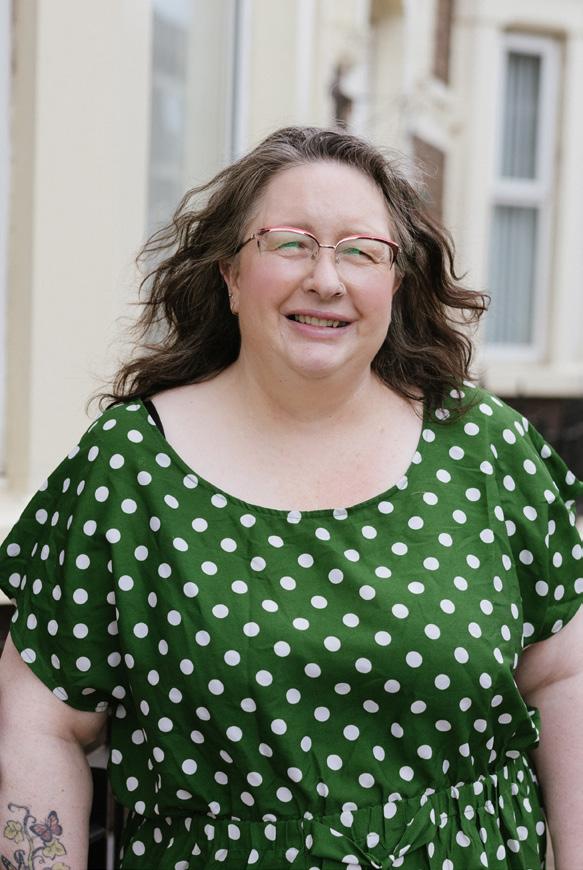

I am Dr Josh Blamire, a Research Fellow at the Institute for Community Research and Development (ICRD). My research explores how different individuals and communities respond to challenges such as austerity, Brexit, Covid-19, and the cost-of-living crisis, as well as to longerterm social change. I work with a range of neighbourhood, community and voluntary organisations, charities, political parties, third sector organisations and local authorities. I am concerned with addressing inequalities and creating the good-quality spaces and places together so that neighbourhoods and communities may thrive.
My interest in the project was sparked having recently moved to a house in Liverpool that is soon celebrating its hundredth-year, so I know all about a draughty home! I was keen to work with Homebaked CLT to learn more about how we can make our homes warmer and cosier, ourselves healthier, and our communities more sustainable in this time of energy and climate crisis. Beyond that, I am a frequent visitor to Anfield as a Liverpool FC season ticket-holder, and have much love for the people and the area!
Hey! I’m Tom, a local artist based in Tuebrook. I grew up in Croxteth Park and have been living with friends around Newsham Park since finishing my fine art course at Liverpool John Moores University in 2018. I enjoy drawing, making sculptures and using everyday materials to make light installations. Over the last few years I’ve been installing these in different spaces around the city, including derelict buildings and club spaces.
Before doing this research with the Cosy Homes Club, I was working nights at a call centre. I done this for just over 5 years and was feeling stuck both with my art as well as the job I was doing and because I’d been there so long it felt like a massive decision to leave. Finding this has not only helped me through that but has given me loads of new experience as well. It has been boss to get stuck in with something I’ve never done before and I’ve found I’ve really enjoyed the process, as well as getting to know new people and all the amazing stuff happening in Anfield and Everton.
Alongside this I have been developing my own business running art workshops for different groups based in the community, hopefully to inspire more people to get into arts and crafts and have been running these over the Summer. I am much happier and think that is the key thing really!
When the opportunity arose to work for Homebaked CLT, I jumped on it. To work alongside such amazing people and projects, couldn’t be missed.
I’ve always been interested in environmental issues, ever since I was in school. I gained a few qualifications in Environmental Studies over the years, so I thought I’d put them to good use. Working with the Cosy Homes Club has been a great experience, I’ve learnt new things and met some wonderful people.
My work as a Citizen Researcher is running along side my own business, Crafty Art Sudio. I started my business after I finished working as a Teaching Assistant, before covid, due to ill health. It started as something to do, to stop the boredom during the pandemic lockdowns. My daughter suggested selling my many, many resin projects, at a market, and it all started from there. I make resin jewellery and trinkets in a gothic style and print on mugs, water bottles, canvas bags plus much more. You can find me at the Homebaked CLT Fairs and my online shop craftyartstudio. com.
Hi I’m Emily. I have been living in Everton for the past 6 years having moved here from the Lake District to study at university. I fell in love with the area and now live here with my husband and 2 year old son.
As well as being a citizen researcher for Homebaked CLT, I also work for the city council library service, as well as doing history research on St George’s Church and the local area, I then also teach chess to young kids.
I got into this project because I was interested in doing research that is based within the community, rather than the desk work that I am used to. I also wanted to be involved with something that people I knew would benefit from. I have loved speaking to people in the community and hearing the stories of those who lived here past and present.
I hope that with our work we have been able to accurately tell the voice of the people of Everton, and create something that people find useful. I have learnt so much about the community and hopefully will take my new skills in community research to new projects.
Citizen Researcher Helen Houghton gives us an honest account of her family’s experience of retrofitting their home.
Last winter we had a range of retrofit work done to our terraced house in Anfield. I found out about the retrofitting after an unsolicited knock on the door. I normally send them away, but I heard the words “solid wall insulation”, and that it would be free under the ECO4 scheme and with receiving certain benefits.
Although keen to save energy, from a financial point of view, as well as environmental, my primary concern was how much disruption there would be with the amount of work recommended to retrofit my home. Solid wall insulation, an improved boiler including all new pipes and radiators, extra loft insulation, and fan extractors made up quite a substantial package of works!
One thing I had not anticipated was that some of the original features of my home would be lost. Parts of the ceiling architrave and the original picture rail had to be covered up in sacrifice for the retrofit, and there was the expense and hassle of redecorating (because work has been completed in every room, the cost aspect has become a bit of a monster!) The daily grind of moving fur-
niture and having strangers in my home was also stressful.
However, despite all of that, it was very much worth all the dust, dirt, and clean-up to feel that warmth and cosiness during the winter, with such a small use of energy. And even with our short summer, we have noticed that the solid wall insulation has even helped keep our home cooler, which wasn’t something I’d foreseen!
We had 20cm of internal solid wall insulation added, which is an intrusive measure, but it really has made such a difference to the energy bills, as the reduced energy usage directly correlates with lower bills, which will continue to provide financial relief over time. We didn’t have to pay anything for the work to our home up front, because the initial cost was covered by my energy company. It will be recouped by them through an additional amount added to our bills, but even with this, we are still paying a lot less than we were before.
As with any construction work, there are ups and downs, but in my experience, the savings for my purse AND the environment make it a win win!

This August ten of our Cosy Homes Club and members of the Homebaked CLT team took a field trip to Birmingham. We met with two fantastic community organisations also looking at ways to retrofit their neighbourhoods: Civic Square and Retrofit Balsall Heath. Our hope was to learn through their experience, hear about the struggles they faced along the way, and see how this may help shape the future of Homebaked CLT as a community organisation.
Find out more about what we’re doing, or sign up to our newsletter on our website: www.homebaked.org.uk

Firstly, we visited Civic Square, an organisation led by people that for 10 years have worked to bring the community together to create an environment where people enjoy living. Their approach puts local people at the forefront of the project whilst having conversations about the bigger picture so that they can have a say on what they want to see happen in the future of their community.
Our hosts took us to visit an area of land next to Edgbaston Reservoir which used to
house The Tower Ballroom. The ballroom opened as a roller skating rink in the 1870s, and was demolished in 2022, despite a local campaign to save it. Earlier this year the site was put up for sale with a current master plan that would greatly impact the local communities’ access to this inner-city green space, as it would involve an area of the walkway around the reservoir being made private. Civic Square are working towards seeing this land developed with the community and for the community.
Next, we visited somewhere that proves the potential of the community coming together: the ‘Red Shed’, officially called the Birmingham Settlement Nature & Wellbeing Centre. A dedicated community space that hosts many different events and sessions for the local community, this environmentally friendly building is a hub for local activity, and the location of Civic Square’s Neighbourhood Trade School. Around the corner is Link Road, a terraced street not dissimilar to
those in Anfield, where Civic Square have been working with residents to test what retrofit could mean for them. One example is a grant scheme, where residents can access funding that must be used to create something for the local community. This grant has funded a communal composter as well as little libraries and bat boxes dotted around the neighbourhood! The terraced houses are very typical for this area of Birmingham and they hope to use the learning and experience from this street to share the benefits more widely.
At their base we talked about the difficulties of finding money for projects that are rooted in the wants of the community, while also working alongside the council. This was also a great opportunity for our team to have a sit down and connect with other people working in similar ways to us, and Civic Square provided some fantastic food at their weekly neighbourhood lunch, which we were very grateful for.
Before heading back to Liverpool we met some of the people behind Retrofit Balsall Heath for a picnic in the park, complete with banners, a hammock and fantastic samosas! Retrofit Balsall Heath have successfully managed to retrofit 650 houses in their local area, by working with Birmingham City Council to use the government’s Local Authority Delivery phase 3 (LAD3) fund, and are now looking at testing a whole street approach. As well as being a great opportunity for our Cosy Homes Club and wider team to get to know each other better, it was encouraging to hear that there are others working towards a mission of healthier homes across the country, and to share our own stories of developing a community led retrofit scheme. It gave us hope that our project is achievable as other people have already made such progress and made it through some of the struggles that we, and lots of community schemes, have been facing. Speaking to like minded individuals was a great experience, and helped us to realise that we are not alone in this adventure.
Josh Coates
Homebaked CLT Engagement lead, Mystery Theatre Club Founder
At Homebaked CLT, we talk a lot about what it means to live well. To have a roof over your head. To have a cosy home. To have a hot meal and find spaces to gather with your community. These are really basic needs yet we still find ourselves fighting for them on the daily.
The Cosy Homes Club is a group of local people working together towards one part of this; we believe everyone deserves a warm and healthy home.
When working with our brilliant group of local Energy Champions, we discussed how we wanted to get information about energy efficiency out into our community. Two of our champions, Helen and Colin, had the great idea of creating a piece of community theatre.
Homebaked CLT has a history with the theatre. Who remembers ‘Homebaked: The Musical’ at the Royal Court? Or our ‘Anfield Home Tour’ back in 2012? Theatre is in our blood and has shaped the blueprints of a lot of our
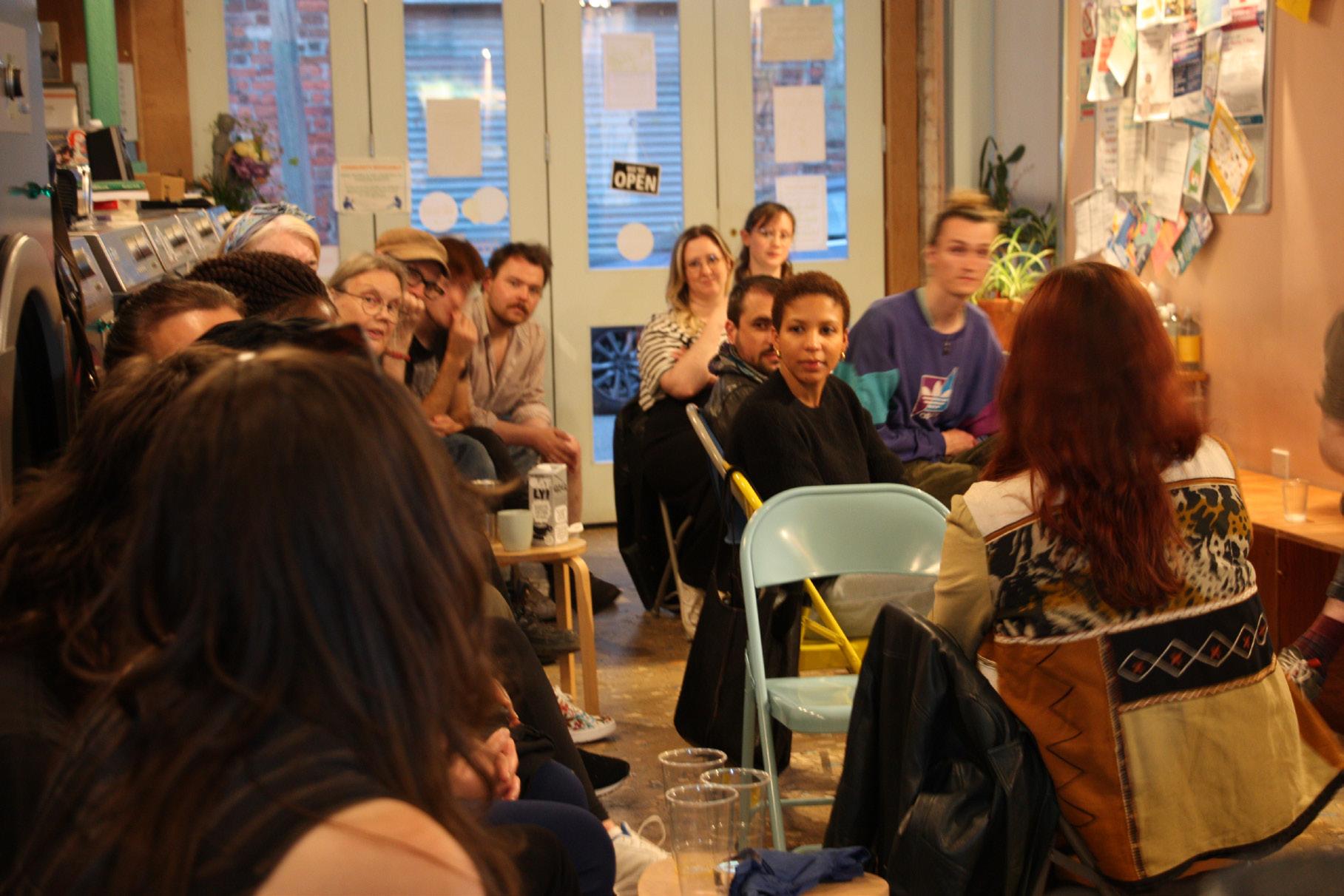
work. Was there an example we could look to for inspiration?
As well as being a member of the Homebaked CLT team I run the Mystery Theatre Club at Kitty’s Launderette. Immediately I embraced the connection between my love of theatre and the work of the Cosy Homes Club. Researching the depths of the internet, I found ‘Dampbusters!’, a community play created by Easthall Theatre Group. The play responds to what residents in the eastern suburbs of Glasgow saw as their own ‘culture’: the penicillium and aspergillus moulds growing on the walls of their flats, and was performed around Glasgow during the City of Culture in 1990 to raise awareness of the health risks inherent in damp housing.
In May, the Mystery Theatre Club and Cosy Homes Club came together and invited our neighbours down to Kitty’s Laundrette to watch this piece of theatre on the big screen. The wonderful Fish Wife, a local supper club, provided some lovely vegan scran and CLT board member Anthony provided brews to the sold out crowd.
‘Dampbusters!’ follows Jimmy, Maggie, and their family and centres around the work of housing and poverty activist Cathy McCormack, who lived most of her adult life unemployed in Easterhouse. Suffering the effects of damp and mould in her own home, Cathy pioneered a collaborative project between her neighbours in Easthall and Easterhouse and expert
researchers. The project resulted in a demonstration home retrofit scheme which simultaneously eliminated dampness and fungal spore infestation; reduced poverty by huge fuel savings; improved mental and physical health; and massively reduced carbon dioxide emissions - an important precursor to the retrofit measures we are exploring as part of the Cosy Homes Club. The piece resonated with many in our audience, and the themes of illness caused by household damp, struggling to pay the bills and feeling ignored by those in power felt all too familiar. One of our neighbours said:
“You could literally pick that up, put it in
Liverpool in 2024 and it would be the exact same play
Despite seemingly little progress since the 1990s, we ended our conversation with a growing sense of solidarity, that we’re not alone in this struggle, and that working together is the way to create lasting change that can benefit us all.
E
: Tell us who you are, how long you have been living here, and a little bit about yourself.
M:My name is Maria Navarro. My married name is Spike, but I go by Maria Navarro. I think it sounds so much nicer. I’ve lived in Anfield for 35 years; I’m 61. I am one of 10 children, the third youngest, and I have 3 sons, 12 grandchildren, and 3 step children also. I am now widowed by 4 years, and I go to St Georges Church.
E
: How many [of your family] live with you at the moment?
M: One lives with me at home at the moment. He is my youngest [at] 36. He and his children are very much present in his life and mine.
E: Tell us a little bit about living in Anfield.
M
:The changes in Anfield have been massive, not always for the good. When I came to live in Anfield it was on Venmore Street. It was a three-bedroom big house, three floors. The house was beautiful. We had a yard which could have been made into a garden. It was beautiful, and we had fantastic neighbors. We had street parties and barbecues. I was a mum [and] my youngest then was only two weeks old. We had so many local shops. We had a butchers, and a chandlers, where you could get anything - a toothbrush, or a mop for your floor. There was a launderette, a vegetable shop, a grocery shop, a cleaners. And we had a bakery, which was Mitchell’s, at the side. Everybody went there ‘cause we



used to buy fresh everyday. I think a lot of people did in them days. We never used supermarkets as such. So even though we had the football ground on our doorstep we still had lots local. Now I live on Kemp Avenue. I still go to Homebaked for my bread, and if the kids are coming down and if I can afford it I will get a few little cakes, because there is nothing better than fresh.
Above: Maria at home. Image credit: Rachael Branton
Right: Venmore Street, tinned up for demoltion. Image credit: Bikeboy, https:// www.geograph. org.uk/photo/3816039
Left: Auspicious cakes for sale at the old Mitchell’s Bakery
“If I can afford it I will get a few little cakes, because there is nothing better than fresh.
E: Is your current house one of the new builds?
M: It is a new build, yes. They’re from the demolition of our old houses on the V streets, as we used to call them, Venmore, Viena... We stuck around as much as we could and we fought as much as we could, [but] Liverpool wanted us out, simple as that really. So [the houses] all came down and we ended up going into these new builds. Do I prefer the new builds? No. Although my neighbours are some nice people.
E: Would that have been about 15 years ago?
M: Yes. So they’re not classed as new builds as such now are they? They’ve built new houses on Venmore Street now. But they were really, really, lovely houses, the old houses. I’ve got 4 bedrooms now. They upgraded everybody, because not a lot of people were happy about it. They had been there for so long and a lot of people owned them as well - I never, I rent mine.
E
: What do you think of them [your housing association]?
M
: Hmm. They aren’t all that. There is a lot of paperwork and writing to you, but it means nothing. They
“ ...they were really, really, lovely houses, the old houses...
are quick should you miss your rent for any reason, they’re on your doorstep then. But when you ask them to do any repairs or anything, you’re waiting forever to get it done. The garage door broke and I had done everything to try and pull it down and I phoned and phoned and filled out forms, and it was getting dark. It was during the winter. They said: “Can you not just leave it till tomorrow morning?”. My garage door is open, people can go in and all over my stuff! I wouldn’t say they are very reliable.

E: Would you say your house is warm in the winter?
M: No, no. The draughts come from everywhere. Can I put a finger on where the draughts are coming from? No, and the wind can sometimes just howl through. I’ve had so many leaks in my
house it’s unreal. I’ve had so many things break, it’s unreal. So many doors squeak from the day we got in.
E: Do you know roughly how much you pay for your gas and electricity?
M: I pay easily about £80 a month for my gas
and about £67 for my lecky. It’s expensive as you know. They threaten every so many months to take it up, and I can literally feel the blood draining from me because I’m like: “How am I going to do this? I won’t have enough money to do this and buy shopping to see me through”. And they do listen. I’ve got to speak the

“I can literally feel the blood draining from me... I won’t have enough money to do this and buy shopping to see
truth, both companies have listened. But if I didn’t have the energy or the mentality to go back on the phone forever trying to get through, I’d give up. Some people would let that go ahead. They would get the letter in the post, see it and go: “That’s what it is”. A lot of people wouldn’t think they have the right to say to them: “You can’t take that money”.
E: How often do you check your bills?
M: I don’t know how to. I don’t get them on written paper anymore [so] I haven’t got a clue. I find myself being all stressed out, feeling totally silly and stupid. There is too much going on, and as long as you’ve still got gas and electricity for your
family that’s the main thing. People who are older than me, it must stress them out. The older generation tends to say okay to everything.
E: How warm do you like your house?
M: So I went round and turned a lot of my radiators off. Others I have lowered - I am quite happy to put extra clothing on, that suits me fine. But my lad who lives at home tends to feel the cold quite a lot, or if I have the grandchildren staying with me and they are like: “Nanny it’s cold!”. I don’t think the house holds the heat like the old houses used to. Because years ago, people always had open fires. The electric radiators we have now are rubbish.
family that’s the main thing.
E: Have you or the housing association done any sort of retrofit and would you be interested in having any work done in the future?
E: What would you like to see in Anfield going forwards?
“I find myself being all stressed out, feeling totally silly and stupid. There is too much going on... as long as you’ve still got gas and electricity for your “ We’ve had to come back together again...
M: Now, funny enough I got a letter today actually. They are going to come out to the house and check all the windows in the house and all the doors. If it had been 5 years ago, I would have gone ahead, [because I was] a little bit more financially settled, [and could afford] to do any repairs myself. Now, I would say, well, what damage would it do? What do I have to do afterwards? Would it cost me anything afterwards? Could I afford to pay for the extra decorating?
M: It would definitely be something for the children. I think we need to bring the younger and the older generation together - there has been a lot of separation and a lot of respect lost amongst our young ones with the older generation. But I think we need to throw something at the children. I don’t know what. I think they need to bring a lot more of these shops back … I love Anfield [football stadium], but it’s become too big. I think it’s a massive problem now. It should never have been built up like that where they took a bit of the
park away [when] they don’t do enough in the area for the children. I don’t think it’s fair that they want the support, but they took all our local shops from around there, they’ve moved a lot of our local people out, [and taken] a lot of our properties down.
E: Have you seen any positive changes to Anfield?
M: We’ve had to come back together again. The communities are there again. People are starting to look out for each other again. People are generous. They see someone who is down, who needs something [and they help], even if it is just being someone there to speak to.

...people are starting to look out for each other again.
Scott Kitty’s Launderette
For many people doing the laundry is a chore they’d wish to avoid, but when paired with colder winter months and/or a lack of white goods and space the stress caused can become a real barrier.
Here at Kitty’s Launderette we often hear stories of the issues people face when drying their clothes at home. With costs of running household appliances ever rising, hang drying clothes indoors has become all the more common. Although this drying method is often used out of necessity it’s an unfortunate fact that if not done under the right conditions it can lead to serious issues. When wet clothes come out of the washing machine they are holding a considerable amount of moisture. If that moisture has nowhere to go during the drying process then we start to see condensation forming on surrounding cold surfaces. It’s cold, damp surfaces where mould grows most. The risk factors associated with exposure to damp and mould include but are not limited to: increased risk of airway infections,
Since our opening in 2019, Kitty’s Launderette has seen a huge rise in the number of people using our washing facilities. Many have expressed that they feel it’s now cheaper to use the dryer at a launderette to save the cost it’d take to run your own.
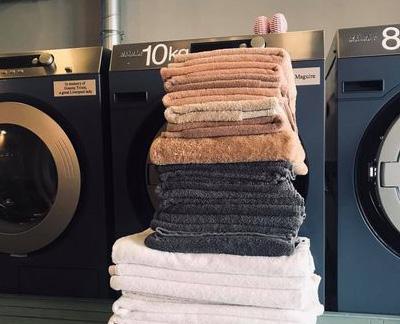
development or worsening of allergic airway diseases and eczema.
After the tragic death of two year old Awaab Ishak in 2020 as a direct result of exposure to mould, Awaab’s Law was introduced in the landmark Social Housing Regulation Act 2023 making it a legal requirement for social landlords to investigate and
Our launderette is a notfor-profit social enterprise which means we don’t exist to make profit but rather use the business to create meaningful social impact across our community. One of these social impact aims is to reduce hygiene poverty. Hygiene poverty is defined as struggling to afford the things to ensure that you can maintain personal hygiene i.e. laundry detergent, shampoo, sanitary towels etc.

We believe that washing and drying your clothes should not have to be a luxury. One of our strategies to try and
fix reported health hazards within specified timeframes. See the resource list at the end of this article for more information on charities and organisations who support tenants facing issues with landlords in both the social and private sector, or pop into the launderette and speak to one of our team.
reduce hygiene poverty in our area is to distribute free washing vouchers to local community partners such as food pantries and children’s centres. We also encourage anyone who needs to use our washing facilities for free to let a member of our team in the launderette know who will then arrange vouchers for you to use at our space.
As part of our partnership and support of the Cosy Homes Club project we’ve included a £5 off voucher that can be used for any of our services up until 31/10/2024. (See the back page)
Why not pop in and say hello over a cuppa and… we might even treat you to some more exclusive laundry tips!
We know that coming into the winter months some people may end up drying their clothes at home. As your local neighbourhood laundry experts we’ve collated some tricks and tips for ensuring you’re drying as safely and effectively as possible.
Make sure you don’t overfill your washing machine as clothes will retain more moisture.
Try to take your clothes out of the washer as quickly after the cycle as mould can start to grow rapidly in humid and warm post wash conditions.
Try to avoid drying your clothes on the radiator as it creates excess condensation. Rather try to use a clothes airer and keep clothes as far apart as possible.
Make sure you position your drying near an open window to ensure adequate air flow.
Think about using an extractor fan or dehumidifier if you have them available.
Resource List
Support and information
Shelter www.shelter.org.uk
ACORN www.acorntheunion.org.uk
Citizens Advice www.citizensadvice.org.uk Vauxhall Law Centre www.vauxhalllawcentre.org.uk
What does good food mean to you? How does food relate to our sense of identity, to our culture and to our sense of place?
Commissioned by Feeding Liverpool, Photographer Emma Case has spent time collecting stories from individuals and families within local communities around Liverpool.
Whilst cooking and eating together there have been rich conversations reflecting on what makes us who we are, how we connect to our roots and to each other.
Feeding Liverpool aims to help people have the power, voice and resources to shape their local food environments and the food system as a whole. Their work focuses on enabling food citizenship, tackling food insecurity and improving access to good food.
Feeding Liverpool is the city’s food alliance, connecting and equipping people and organisations to work towards Good Food for All.
In 2021 Emma started asking residents, “What does good food mean to you?” We heard how good food can make us feel empowered, dignified, connected, joyful, nostalgic. Residents shared the importance of good food being for everyone, and how food is entwined with our senses of belonging, rootedness and connection to each other and this city.
Good Food; Our Food begins to share these stories.

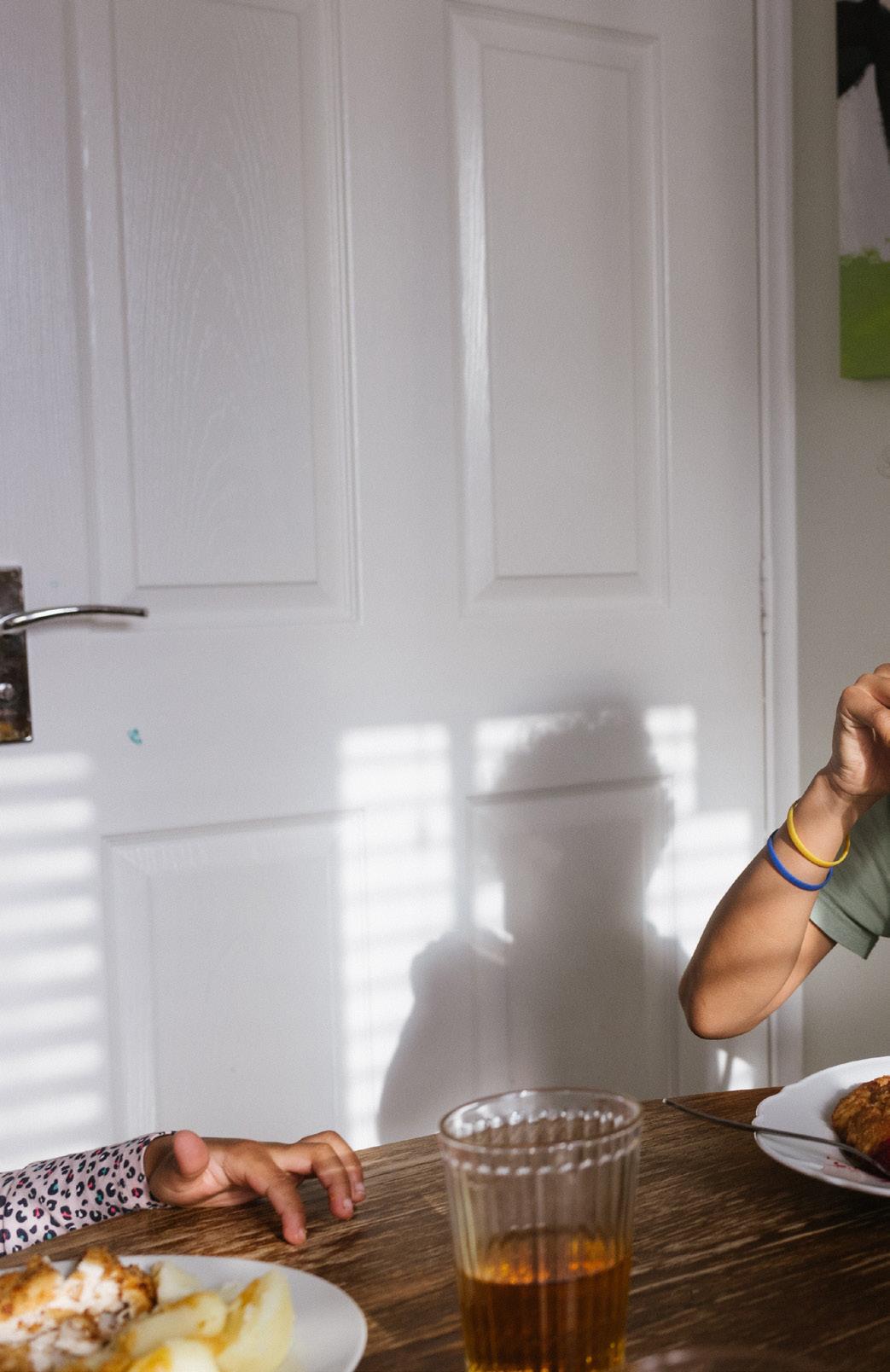
Esra
Where I live now, when I want to cook dishes from my home country I struggle to find things to buy. Spices are easy to get but it’s difficult to buy halaal meat and fresh coriander, but all these things I can find on Lodge Lane. When I’m [there] I feel like I’m in my home country. I remember my street at home. The way it was always crowded. The sweet shops.
I would love to have my own food business. Before,
I worked as a Carer. I would visit them in their homes. The food was always the same and they would cry. From Monday to Friday they would have microwave meals only as they can’t cook themselves. I would cook from my house for them. I have five children so I would cook for my family and also for my clients at work. They were all English but they liked my food. I would make them Falafel, rice and meat and for their birthday I would make a cake for them.


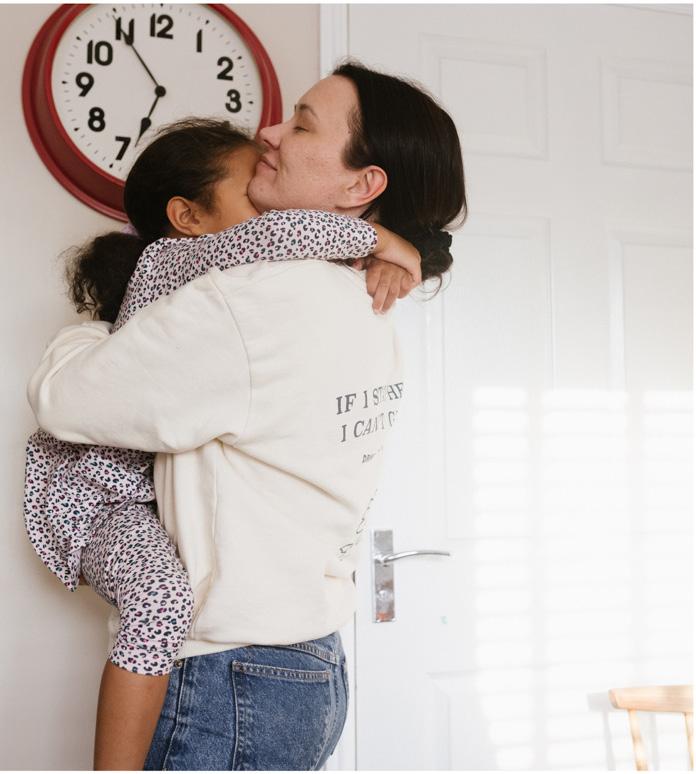
I moved to England when I was nineteen, and there were no Polish shops back then. I think the first Polish shop opened in 2007. It was on Picton Road and we were living in Anfield so it was miles away. We didn’t go a lot as we’d have to carry it back home and we didn’t have a car. There was a small Polish community and we would tell each other where to buy things that taste ‘almost’ like they are from home - chicken pates and bread that almost tastes like it’s Polish.
At the time we all had low paid jobs, and you never knew if your hours were going to be cut so you’d make sure your money went as far as possible. Money was tight so going shopping you could only take so many risks to try things that might taste like food from home. You would give up after a while as you would find things and ‘Hmm, it’s not the same’, or you’d have to eat things you don’t enjoy because it was either eating that or not eating at all.
Bianca will do anything for fried chicken, she’s very much daddy’s girl. As long as chicken is involved, daddy will have it. He’s converted now to Polish chicken, and potatoes. So in Jamaica they eat yam which is in the same family as the potato but slightly different. They don’t create the meal around potatoes whereas in Poland you have potatoes, this is your base and then it’s what you have with your potatoes.
Ever since my mum passed away, it was bizarre, it really hit me. I was thinking, oh my god, if anything happened to me, that’s it, the whole aspect of being Polish... gone. I got almost obsessive. Before I would shop in Asda or Tesco as they have Polish sections (although it’s not your true offering), whereas, now I’m even buying my apples in the Polish shop.

It doesn’t matter how old you are, once you lose your parents, that’s your village you know. So even when you do go back, it’s not home anymore, because that anchor is not there. It’s a familiar place but now I go just out of sentiment. I still call it home which is funny because next year I will have spent exactly half of my life in England, but I think I am still very Polish in many ways.
We all talk every day and make effort to spend time with each other. We’re really close, as growing up we didn’t have family here. It was always us. Birthdays were just us five. Eid was just us five. Everything we’ve done it’s always been together.
We tend to bond over food a lot. Dinner time is the time we’re all together, even if we eat out, we eat together. Mum doesn’t really eat western food, like burgers and chips and stuff, so we always try and find a place that caters for both.
So as much as we can we try to eat at the table like this as a family. And the food is so important because that’s what we’re taking about when we’re eating, its the ex-
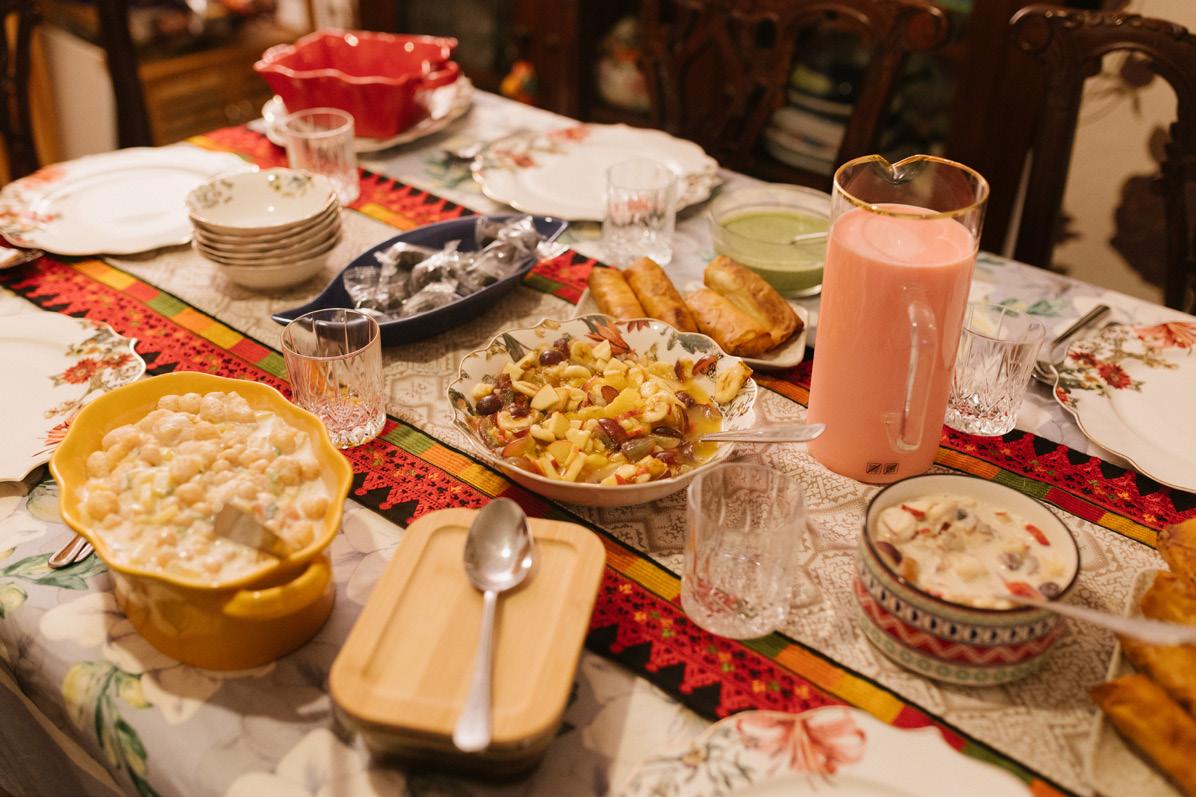
perience we’re going through. So every time we think about food, it’s actually family. It’s so important and things like Eid and Ramadan or cultural and traditional things like wearing our traditional clothes etc, this helps us to
never forget where we’ve come from. If we start getting out of touch with these things, we’ll lose it and we won’t be able to carry it on so its important to us to learn so we can pass on to our kids.
So this vegan dish, we would call this ‘Ital Stew’ - sweet potato, corn, ochra, all the tings that grow in the Caribbean and I might have it with rice or green banana, yam, sweet potato... stuff like that you know?
My dad was a fantastic cook and everybody says, ‘You’ve got the skills from him’ - but you’ve got to understand Jamaican fathers are not someone who sit you down and say “Come son, I’ll show you how to do this”, you have to just look and watch. And if you asked him a question like “Dad, that banana porridge you make, do you make it with green plantain or ripe plantain?” His answer would always be - “Any of them.” But I want a specific answer. His answers were “Mmm hmm. Who tell you that?” and you just had to

live with it, so when he was doing anything, you had to just watch.
With my children I feel its an obligation to pass things on because if you don’t, your culture will die. Your culture has so much to offer, it shouldn’t die, that’s my belief. With my four children, my youngest girl, she can cook. She’s very good. I think she outdoes me sometimes to tell you the truth and she explores even more than I do with the food. She loves the tradition, she loves the culture. She’s always asking about the culture.

Learning to cook I would watch my mum. She’s in Zimbabwe. I’m here with my sister but she lives in Manchester. I get to visit her some weekends. We were living in Manchester but last year we were moved to Liverpool. I would prefer to settle in Manchester because I’ve got a support system there and my daughter had settled well in school, but with the Home Office, accommodation is given on a no choice basis. They have now given me a ‘Permit to work’ so I work in social care. In Manchester I could do longer shifts because me and my sister could share childcare. Here it is difficult as the shifts are long and I can’t do them because I’m just here by myself.
It’s been hard but I’m adjusting and thank goodness for organisations like Refugee Women Connect (RWC) because you can socialise with other women and have support.
I love cooking. It makes me feel good because it reminds me of who I am and where I come from. Whenever I miss home, I just cook this dish and I feel like I’m home. That’s what it’s about and I want the same for my daughter. It will always remind her of who she is, where she comes from. It reminds her of her roots. In this evolving world, everything changes every day, so she needs to know who she is and where she’s coming from.


We moved here in 1999. We were here for a few years and then a lot of our older people asked us about a shop and trying to get Irish goods in for them. So around 2001 we started the shop. The shop means a lot, especially to our older community. Many of them are unable to go home anymore and even the young Irish students that come to Liverpool, they come in regularly during the week to buy stuff from us too.
Through Covid, we had to shut everything down, all the activities, everything stopped. But because it was food, we were allowed to keep the shop open. So that’s what kept us open really because people were coming in regularly, mainly because they couldn’t go to Ireland to get stuff, so they were all coming here. It really kept us going.
Energy-saving meals that are good for you, and your pocket!
In an earlier phase of our work with the Cosy Homes Club, we held slow-cooker workshops with our neighbours. We learned how to make healthy, nutritious meals on a budget using the benefits of a slow-cooker.
Slow cookers are a really efficient way to cook food saving you energy and time. They’re great for batch cooking, too!
Here are two of our favourite recipes from these workshops.
Magical Slow Scouse
Uses a 3.5lt slow cooker
Serves 5-6
Ingredients
2 onions (chopped)
500g diced stewing beef
800g diced lamb
4 carrots (diced)
3 parsnips (diced)
10-12 potatoes (diced)
3 beef stock cubes
2 tbsp worcestershire sauce
800ml water
Salt & pepper to season
To serve Red cabbage Crusty bread
Method
1. Fry the onions and brown the beef & lamb in a frying pan with some oil.
2. Add to slow cooker and add worcestershire sauce and salt & pepper to season.
3. Add vegetables.
4. Add the stock cubes and enough water to cover potatoes.
5. Cook on low for 2-3 hrs.
6. Add little more water and worcestershire sauce to taste, then cook for another 2 hrs.
Serve with red cabbage and crusty bread.
Uses a 3.5lt slow cooker
Serves 5-6
Ingredients
4 onions (finely chopped)
4 carrots (finely chopped)
4 celery sticks (finely chopped
3 garlic cloves (crushed)
1 fresh chilli (finely chopped) or 1 tsp chilli seasoning
salt & pepper
200g dried split red lentils
2 tins of chopped tomatoes
1 tin of kidney beans
650ml vegetable stock (2 cubes)
To serve
Fresh Parsley
Sour cream
Baked potato, rice or tortilla chips
Method
1. Prepare all vegetables and place them in the slow cooker.
2. Add tinned tomatoes, lentils, kidney beans, chili, and season with salt & pepper.
3. Add half the vegetable stock (keep rest for later), stir & then turn on slow cooker to low/ med and cook for 5-6hrs.
4. When cooking time is up the lentils will make it look drynow add the remaining stock.
Serve on baked potato, rice or with tortilla chips, and top with sour creme and chopped parsley

A Lifeline for the Local Community In these challenging times, New Beginnings - Improving Lives CIC has emerged as a crucial support system for residents in our area. This community interest company offers a range of services designed to help those facing hardship and uncertainty.
Emergency Foodbank At the heart of New Beginnings’ operations is their emergency foodbank. Recognizing that food insecurity can strike anyone at any time, the organization provides essential food packages to individuals and families in crisis. These parcels contain a balanced selection of nonperishable items to help tide people over during difficult periods.
Community Store Building on the success of their foodbank, New Beginnings has established a community store. This innovative approach allows local residents to access a wider range of products at significantly reduced prices. The store stocks food, household essentials, and personal care items, making it easier for those on tight budgets to stretch their resources further Find our Community Store at: 63 ROCKY LANE, Anfield, L6 4BB
Wednesday & Thursday 12.30pm - 4.30pm Friday 9.30am - 4.30pm
Benefit and Energy Support Drop-in
Understanding that navigating the benefits system and managing energy costs can be overwhelming, New Beginnings offers a regular drop-in service. Here, trained volunteers provide guidance on:
- Benefit entitlements and application processes
- Energy-saving tips and techniques
- Accessing grants and support for energy bills
- Budgeting advice and financial planning
This service has proven invaluable for many in the community, helping them to maximise their income and reduce unnecessary expenses.
Community Impact Since its inception, New Beginnings has made a significant impact on the local area. Every week New Beginnings helps between 600-700 people across all projects.
As our community continues to face economic challenges, the serviced provided by New Beginnings - Improving Lives CIC stand as a testament to the power of local action and mutual support.
The organisation relies heavily on donations and volunteers from the community.
Those interested in supporting New Beginnings’ vital work can phone us on 0151 271 3066, or email us at info@nbil-community.org.uk
We all want warmer, comfier, greener homes with lower bills but sometimes it seems the options are either to stump up a load of cash for an expensive consultant and builder or go with a retrofit council scheme where you get little choice on how it turns out...
One where we take control and figure out a way to improve our houses together?
Helen Grimshaw Retrofit Research Lead, Carbon Coop
Established in 2011, Carbon Co-op is a community energy organisation based in Manchester. We deliver energy services and projects, advocating for local people and communities in the energy transition and finding ways to tackle climate change together. Friends of Homebaked CLT for some time, we’ve been supporting the work of the Cosy Homes Club. In this article we introduce our collective retrofit project in Levenshulme, South Manchester, where building work has started on upgrading five terraced homes in neighbouring streets.
Back in 2015 we delivered a series of whole house retrofits all around Greater Manchester with a group of our members. We took householders through the process as a group, sitting in the middle and contracting a builder to do the work. At this stage we were still understanding what was possible with different house types, and whether we could reduce heating use significantly by applying combinations of external wall insulation, new windows, better roof insulation etc. It was a huge learning curve for us, but demonstrated that ambitious
retrofit was possible and could deliver very positive outcomes.
Taking what we had learnt, we had ambitions to do community-led retrofit again, but focused on a single area of Manchester. We believe that good quality retrofit, tackled street by street within a neighbourhood, can unlock more than just more efficient, affordable and comfortable homes. That it can generate bill savings, unlock more innovative ways of financing the work and invest in local skills.

The approach we’re taking is focused on:
Setting homes on a path to a whole house retrofit, even if we don’t do everything now. This means we’ve carefully considered a package that is feasible with the money available, should deliver noticeable improvements, and not compromise other works that may come in future.
Centering residents in design and delivery. Carefully considering their needs and wants, being open and transparent and ensuring they are central to what gets delivered and how this is done.
Having a high degree of control around design, specification and installation.
Quality is important to all of our stakeholders - as a community intermediary we can champion and protect this focus on quality in our role.


Alongside lots of conversations locally, we commissioned designers URBED (who were involved with the Homebaked bakery and terrace project) to do a study looking at different house types in the area. Even a terrace that looks the same from the street can have lots of different house types, because we adapt and expand our homes over the years. This helped us develop a more robust brief and start thinking about works that would suit the homes.
We ended up with the following:
Mid and end terraces across three neighbouring streets
All with two storey outriggers at the back
Walls built with a very slim cavity
One home with a single storey extension at the back
Gas central heating and radiators
Limited or no planned ventilation systems.
Alongside this, we ran engagement activities, holding local drop-in events and posting letters through doors. We engaged broadly at this point, and were open to including different tenures (e.g. owner occupiers, private rent and social rent). However, the first phase has ended up with owner occupiers only. We are keen to explore barriers for private landlords as part of evaluation work.
Once we had a group of committed households they received a ‘whole house assessment’ and retrofit plan, completed by our sister co-operative, People Powered Retrofit, which consisted of:
An energy ‘model’ of the home
More detailed than an Energy Performance Certificate (EPC) and allows us to assess the impact of different works like wall insulation on heat loss.
An occupancy survey
This allows us to understand how residents currently use their homes, the temperature they typically heat their home to and their current levels of ‘satisfaction’. We also collect data on their current energy use from bills so that we have a good baseline to compare against (not just a theoretical one!).
Observations about the home’s condition This is a good starting point for understanding what other works and repairs might need to be done first or alongside insulation.
By working to this whole house retrofit plan and taking a ‘fabric first’ approach (trying to reduce the amount of energy a home needs to use before thinking about things like solar panels), we created a standard package, with small tweaks to fit each home and their priorities. This includes:
- loft and roof insulation
- replacement doors
- high performance double glazing
- draught proofing
- improved extract ventilation
- external wall insulation to the rear and side
- improved heating controls
- cap and fill chimneys or chimney balloons.
Once the works were firmed up, we worked with our architect (Progress in Practice) to create detailed designs and submit the scheme for planning permission to the council. Seeking to centre the householders at all stages we held design workshops and meetings for residents to:
Hear more about why we were proposing these works, and which issues we would be paying close attention to (including minimising all the tiny, unseen areas where heat leaks out)
Visit another already retrofitted home with similar works so they could see for themselves, and hear from the resident about the level of disruption etc
Discuss the practicalities, like whether garden features like decking, fences and walls need adjusting for wall insulation, storage needs in lofts and accommodating cat flaps!
Discuss render and window colours.
Placing residents at the heart of the process allows early discussion of things which sometimes seem small in the big picture, but can make a big difference. Selecting an architect who understands what is important to us and our residents makes a big difference here. As a result we were very relieved to sail through Planning!
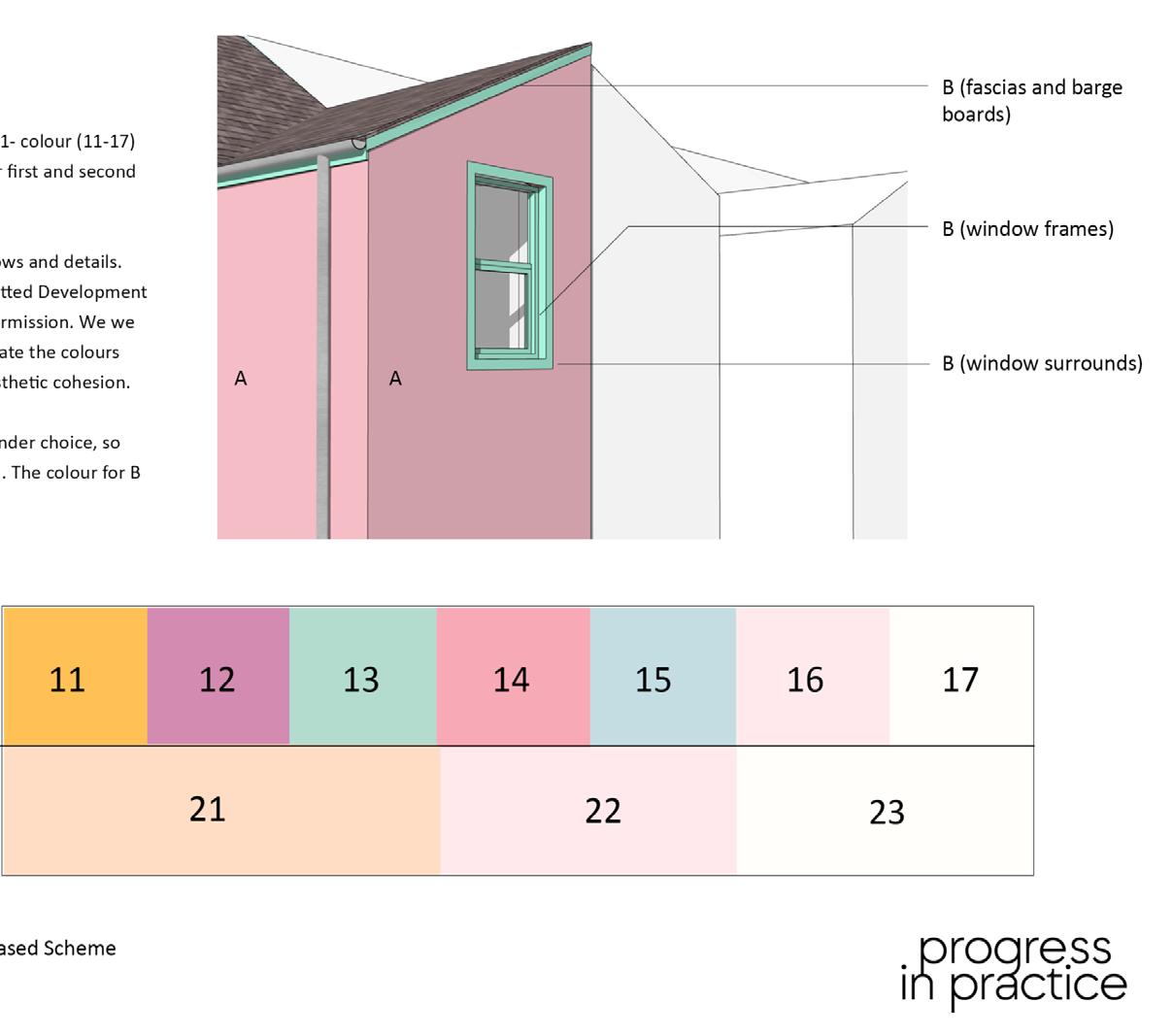
Energy efficiency schemes often use large builders working on a national scale and with big chains of subcontractors. In our experience, these are often headquartered many miles away and the heavy reliance on subcontracting can lead to greater levels of distrust. For delivery in Levenshulme we’re working with B4Box, an Ashden award winning builder and training provider whose work is framed by tackling poverty, addressing

For the Levenshulme project, building works are funded through a mixture of grant money and loans.
Manchester City Council are offering 0% interest free ‘group works’ loans of up to £35,000 per home, which only need to be paid back once householders are selling their home. This type of finance has been generally less daunting for householders as there are no upfront costs. We think there’s huge potential in this approach! The grant pot was funded by the financial re-payments from Carbon Co-op’s 2015 Community Green Deal project and the eligibility for this was set by us, with criteria similar to that used by the local authority in allocating energy supplier
funding.
However, individual circumstances and the grant money not being available for everyone means the incentives for householders to invest in the project vary. Different ‘financial personas’ mean that the motivations also vary, e.g. for young families, those older or if someone thinks they might move house in the near future. In this way, an intermediary like Carbon Co-op plays an important role in staying engaged with householders throughout to understand their position
By combining homes in one project, the process can be more cost-effective because we can purchase design services, surveys, materials
climate change, promoting social justice and addressing inequality.
Our ambition with B4Box is that this project will be the start of an ongoing partnership where we work together to build the supply chain locally, investing in people with the skills to deliver high quality retrofit.
We’ve also received support from the MCS Foundation around skills and training.
We’re really keen to maximise the learning from this project, for ourselves in delivering further Area Based Schemes, and for the wider sectors. To better understand the impact of the works we have:
Fitted monitoring equipment such as temperature, humidity and air quality sensors, providing residents with a dashboard so they can log in and view the data too. Commissioned an external evaluation to get valuable feedback from residents, our delivery team, the builder and partners like the council, and we plan to publish outputs from these as the works progress on site.
so it begins...
Andand labour ‘in bulk.’ As well as the architect, we’ve needed to commission supporting surveys to progress detailed designs. This includes things like:
Airtightness tests (which measures how ‘leaky’ the home is, and helps pinpoint where these are)
Measured surveys (important for accurate costings and material orders)
Asbestos surveys
Condition/structural surveys
Electrical surveys. These kinds of surveys and costs are not often talked about (and often don’t get people excited!) but it is important not to neglect if we really want to deliver quality.
Covid significantly impacted the development of this project and it’s been several years in development but signing contracts and getting loan paperwork approved have been huge milestones, reflecting a huge amount of work by our team. We’re now very excited to see the building work start, and for our residents this is long anticipated. With works expected to be completed in early winter, our residents’ homes will hopefully be much cosier and more energy resilient. And we hope to show what’s possible when you take a community led approach to retrofit.
Tom Doubtfire Cosy Homes Club Citizen Researcher
War going on all over the world. Housing in crisis. People on the streets. Some are angrier at the people put up in hotels than the ones making the weapons down the road. The world needs to be unsafe for who?
When we talk about housing, this is some of the stuff that is unavoidable. It is about the people!
When our neighbours speak of the grief caused by demolitions and their family and friends being split up across the city, this is the same as people being unsafe in another part of the world and being forced to move. Enabling people to feel secure and comfortable in their homes, potentially for the first time, is part of the possible benefits of retrofit. When asked about the future what comes to mind?
We need to consider the reality in front of us when it comes to thinking about the next stages in our mission to retrofit our neighbourhood. We are faced with a housing crisis. If homelessness is a reality for a lot of people in our community, then this should be considered when thinking about being warm and cosy in our homes. We are faced with a climate crisis. The changes in climate and changes in the energy sector also need to be accounted for. Houses made when we predominantly used coal were built to be draughty. Now, we are shifting from gas to electricity in the home. This impacts what we should change about existing houses and there is a desperate need for jobs which respect the earth and
its resources.
Retrofit, as was made clear by those we visited at Civic Square in Birmingham, is both about retrofitting the home but also the street and the community. This means helping people feel more connected and able to take more agency over the places we reside. There are two places in Anfield and Everton which I think sit alongside the work we aim to do and paints a different future for the city. Part of this is through reconnecting with our past, the people who made us who we are today and bringing to life the existing infrastructure that has been left to decay.
Everton Library sits empty on St Domingo Road, opposite St George’s church and just behind the park overlooking



the city. It is the only Shelmerdine architecture left to not be restored in Liverpool and the very visible reminder of lack of care for buildings in our neighbourhood adds to the great sense of loss and grief among local people. Looking through one of the windows on a sunny day shows how beautiful the building still is inside, and speaking to a lollipop lady nearby proves how angry people are at the library being closed. A talk about the past and future of Everton by architectural historian Barnabus Calder, whose work focuses on the link between architecture and energy, began with how demolitions waste our scarce resources. He then spoke of how this library could be brought back to life: various rooms occu-
pied by community groups and services, along with the grand hall reopened for all, and the basement turned into a retrofit training centre. This would give the opportunity for proper education, training and employment for local people to get stuck in with manual and hands on work. And above all else Everton Library would go back to being the vibrant and active space it once was!
Another space filled with grief is Anfield Cemetery. Friends of Anfield are not only trying to give people the proper space to grieve and
show respect to their loved ones but want this to be a site of inspiration for all who visit. One thing that Liverpool isn’t short of is stories. If you walk around the cemetery there are a series of boards along the path, each with a unique story about someone buried there. They hope to reopen the derelict chapel and, like Everton library, turn this building into a space which respects the needs of local people and attracts visitors, alongside being a hub for education and skill sharing.
Measuring social value is the core of many businesses around Anfield and Everton, this includes Homebaked CLT and Kitty’s Launderette along with many more and makes clear if spaces such as Everton Library and Anfield Cemetery were used to their full potential how this could dramatically improve the lives of local people. Social value is measured not by how much profit is in the bank but the impact created in real terms. People are angry, passionate, caring and optimistic. When I think about the potential in both Anfield Cemetery and Everton Library as well as neighbourhood wide retrofit, I see a similar process is needed. It is almost an undoing, of grief, of a disconnection with the past, of the generational gap in skills. A return to skilful craft and meaningful employment. Homes and community spaces rebuilt side by side, and reconnecting with the land.
When you stand and look over the city from the top of Everton Park, take a breath and think of all this city has to offer.
From there we walk into that world.
Amongst all this, there is a hope.
Liverpool Tool Library is driven by community, sharing resources and sustainablility.
For more information, and to find out how the library works, visit our website: www.liverpooltoollibrary.org.uk Or, contact us by email: hello@liverpooltoollibrary.org.uk or by phone: 07340076653 (Opening hours only)
OPEN FOR SHARING Wednesday 4-7pm Saturday 10am-1pm
Unit 5 Aspen Yard 1 Aspen Grove, Liverpool, L8 0SR
Just off Lodge Lane, on the 26/27 bus route!
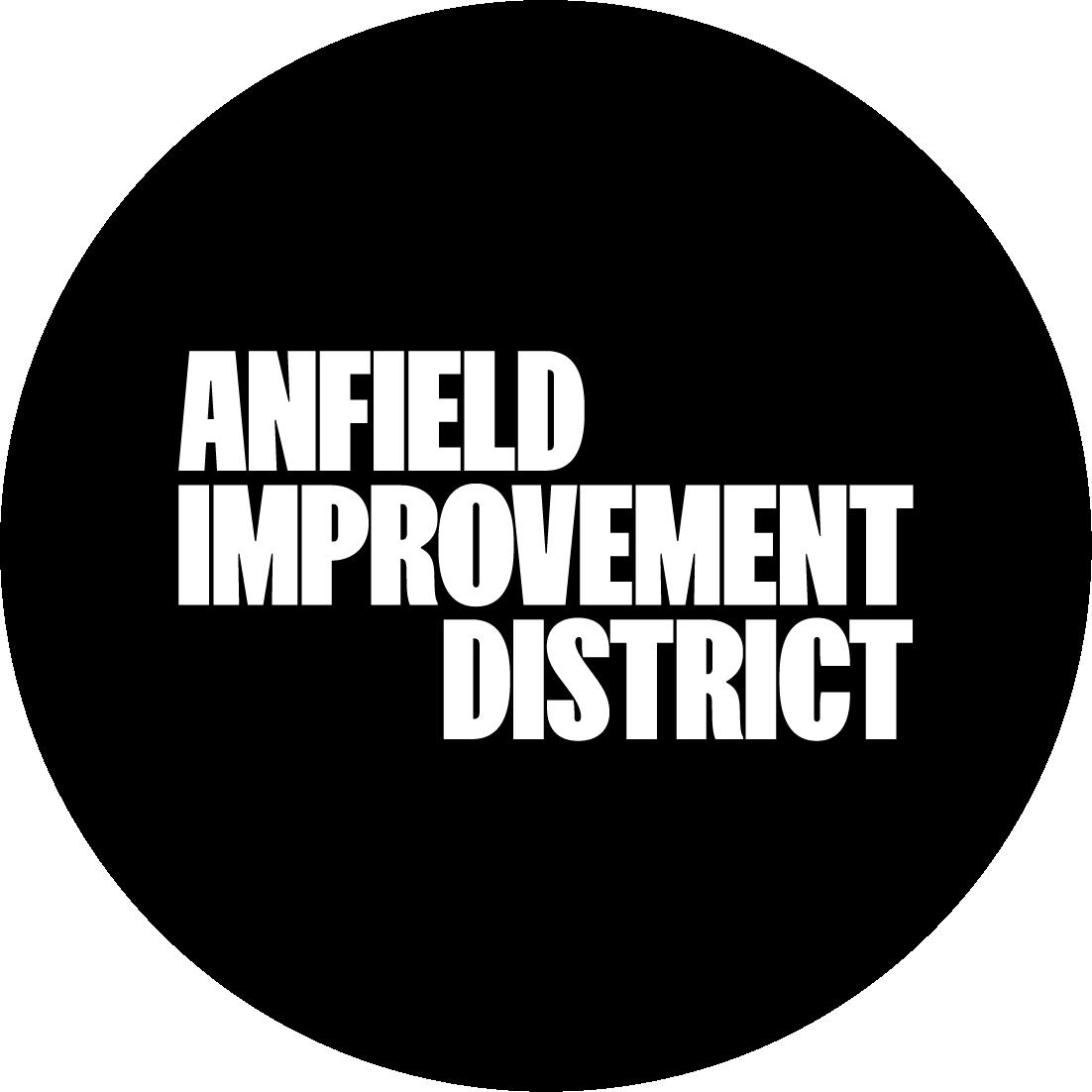
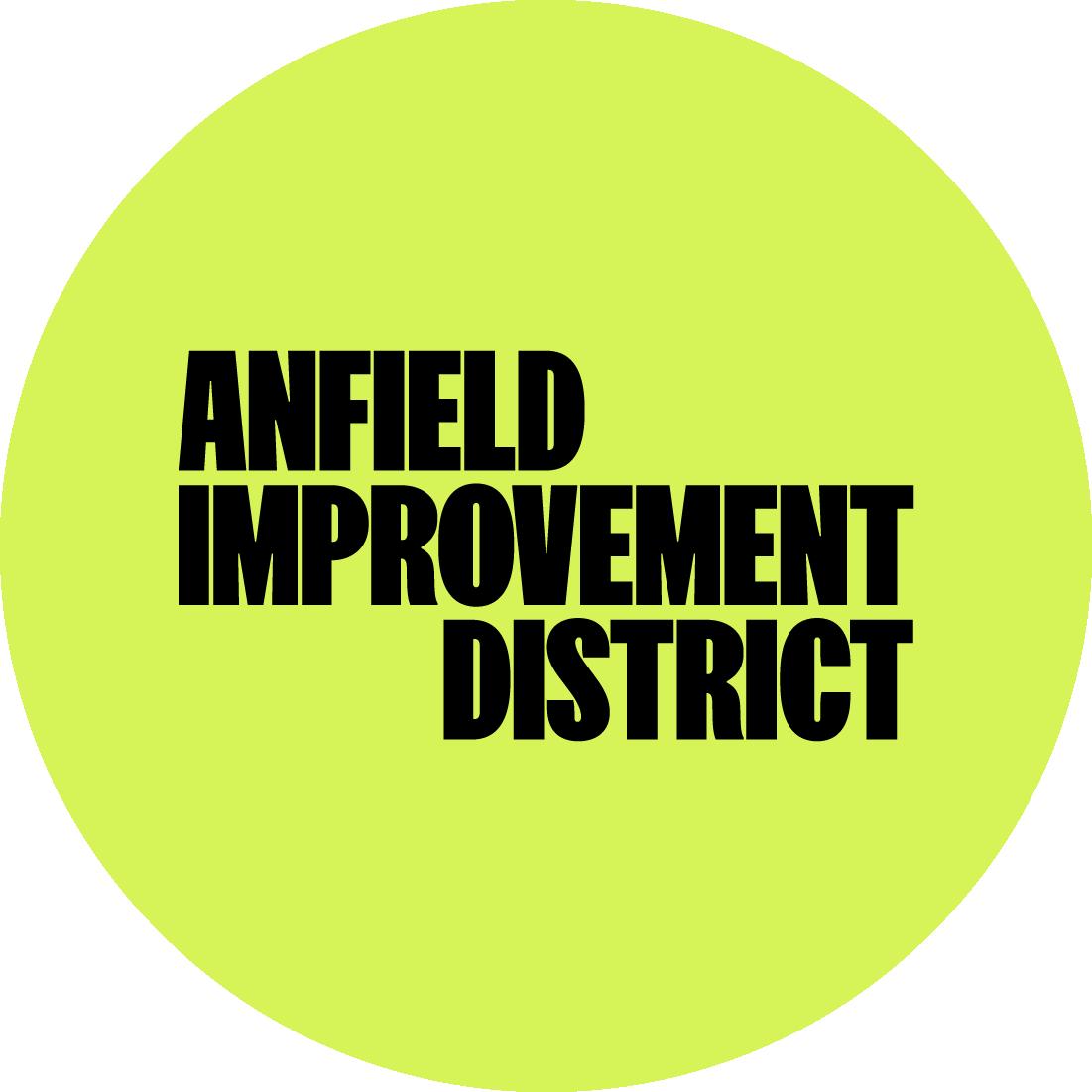

Anfield Improvement District is a collective group of businesses serving Anfield. We are working together to make a shared and community-led vision for a vibrant Anfield. This means a happy and healthy community, where all people feel cared for and listened to, and care and listen in return.
A place where people can build a life, live in their forever home and build a business.
place to be proud of.
If you’d like to find out more or become a member, please email: rachael.treacher@homebaked.org.uk
Since progress on our Oakfield Terrace scheme stalled in April we have been regrouping with you, our members and supporters, as well as trusted partners and experts in the sector.
From the beginning, our neighbours made it clear that they needed warm and affordable homes. Homes that would provide not just for us now, but for future generations, too. They also wanted safe spaces to come together as a community, and a rejuvenated high street with opportunities for good jobs and local businesses to thrive. Our Oakfield Terrace scheme aims to provide all of
So what happens next?
Having taken onboard comments and suggestions from our members and neighbours, we are now pursuing three key actions as next steps to delivering Oakfield Terrace.
- Regrouping with trusted partners, including peers and specialists from the sector, for guidance as we explore viable options moving forward. As always members will contribute to the development of options. We remain committed to delivering a quality scheme that we all deserve.
- Preparing for a collective meeting with the relevant individuals and departments
We need you, our community, neighbours and supporters, now more than ever. We need to come together and stand shoulder to shoulder to deliver the quality that our community asked for and deserves.
Share your skills! Our team and board have many valuable skills and we are building robustness with the support
those things.
As a member-led organisation, our members guide our decision making and direction. Since recent events, including the withdrawal of our development partner Your Housing Group, we need to come together to make sure we can deliver a scheme that meets the needs and aspirations of our community whilst being financially viable and value for money.
On 14th August, we held an open meeting for members and neighbours to come together, have a full update on our progress, ask questions and find solutions together.
of Liverpool City Council as a necessary key partner and the freeholder of the terrace. As the current owner, LCC ultimately has control over how the terrace is transferred into community ownership. While they remain the freeholder, there are significant limitations on what can be achieved. We remain committed to a strong and positive working relationship with LCC to ensure we can collectively deliver Oakfield Terrace for the community as quickly as possible.
- Securing a new development partner. We have already had a number of positive meetings with one potential partner, and are
of trusted partners. If you have skills or experience that you think would help us, please let us know.
Join the core design team! We are reconvening our previous core design team (the group of local people who steered the current design for the scheme). If you would be interested in getting involved with the next stage of this process, email Tom: tom.murphy@homebaked.org.uk
Over 40 of you joined us and, despite the understandable frustrations of the issues we’ve faced, there was a really positive and unifying atmosphere. We really appreciate all the questions, comments and feedback we received, and it was encouraging to see so many conversations continuing as the evening went on. We also greatly appreciate the many messages of solidarity and offers of support we’ve received in recent weeks. If you weren’t able to join us, or would like to learn more, visit our website for further details and FAQs.
building relationships with a number of others locally. Until new government funding programmes are announced (which we expect to have more information about in the Autumn statement), no commitments can be made. However we are hopeful that we will have secured a new development partner and be working with them effectively by the end of the year. In order to do this well, we will be creating robust partnership agreements to ensure clarity of roles and expectations: not just what we are doing together but how we will be doing it, to ensure the CLT has full visibility and more control over progress.
Despite all the challenges and setbacks we have faced, we’re not giving up!
We all make up the CLT and together we can achieve true community ownership in our neighbourhood.
Answers on page 21
Down
1. Making sure something will remain useful (6-5)
2. Long term change in average weather patterns(7-6)
3. One part of the area where Homebaked CLT work (7)
4. A balance between the carbon emitted into, and removed from, the atmosphere (3-4)
5. What we all need to stay warm, cook and keep the lights on (6)
9. The people who live near us (10)
11. Phrase used to describe the release of gases into the atmosphere through human activity (6-9)
13. Currents of cool air in a room (8)
Across
6. A local, member led organisation (9-3)
7. How we would like to feel in winter (4)
8. What could be done to your home to make it more efficient (8)
10. Join us if you want to get involved! (4-5-4)
12. There’s a lot of terraced ……. round here (7)
14. In an ideal world, everyone would live in one (4)

15. This newspaper, a combined effort (6-5)
16. The other part of the area where Homebaked CLT work (7)
17. Adding this can keep a house warmer in winter and cooler in summer (10)
18. A group of people living in the same area, or with a particular characteristic in common (9)
19. Mutual support within a group (10)
20. This can convert energy from the sun into electricity (5-5)
Warmer, drier summers and warmer wetter winters, More frequent and intense weather extremes expected throughout the year.

COUPON VALID SEPT AND OCT 2024
Offer redeemable at business owner’s discretion.
Find us at: 9 UTTING AVENUE, L4 7UN Tue-Fri, 10am-4pm Sat,10am-2pm

Summers are projected to be up to 6°C warmer, and up to 60% drier (depending on the region). However when it does rain, the intensity is expected to increase by up to 20%. Days when rainfall exceeds 30mm per hour are projected to occur twice as often - this is the point that flash flood alerts are issued.
Winters projected to be up to 4.5°C warmer, and up to 30% wetter. The intensity of rain increased by up to 25%.
IT’S NEARLY TIME TO BLEED YOUR RADIATORS!
Come along to any Homebaked CLT activity to exchange this coupon for a free radiator key. (offer available whilst stocks last) £5 off a £40 booking at The Therapeutic Garden with this coupon! Rest & Relax with Reflexology SAVE £5 £5 OFF FOR EVERY £50 SPENT!
To book, contact Jan at: therapeuticgardener@ gmail.com or phone: 07581 482186
Offer redeemable at business owner’s discretion.
